| It has been suggested that this work be split into multiple pages. If you'd like to help, please review the style guidelines and help pages. |
ILLUSTRATIONS
OF
EXOTIC ENTOMOLOGY,
CONTAINING
UPWARDS OF SIX HUNDRED AND FIFTY
FIGURES AND DESCRIPTIONS
OF
FOREIGN INSECTS,
INTERSPERSED WITH
REMARKS AND REFLECTIONS ON THEIR NATURE AND PROPERTIES.
BY DRU DRURY.
A NEW EDITION,
BROUGHT DOWN TO THE PRESENT STATE OF THE SCIENCE,
WITH THE SYSTEMATIC CHARACTERS OF EACH SPECIES, SYNONYMS, INDEXES,
AND OTHER ADDITIONAL MATTER.
BY J. O. WESTWOOD, F.L.S.
SOC. CÆS. NAT. CUR. MOSQ. SOC.
ETC. ETC.
VOL. III.
LONDON:
HENRY G. BOHN, 4, YORK STREET, COVENT GARDEN.
MDCCCXXXVII.
MR. DRURY'S PREFACE
TO THE FIRST EDITION.
VOL. III.
Grateful for the favourable reception the two preceding volumes of this work have met from the lovers of Natural History, it is with pleasure that I now present them, though late, with this my third and last volume, which has been completed in opposition to greater disadvantages and disappointments than attended either of the others.
It may not be superfluous to inform my readers, that this publication is the result of such leisure hours only as could be spared from an indispensable assiduity to immediate business, and a necessary attention, at that time, to an impaired constitution.
This being taken into consideration, little apology will be required for the length of time I have been in bringing it out, by those who know what trouble we must necessarily have with the various artists, who are employed in executing the different parts of such a work, and with what scrupulous exactness and care every minute part ought to be examined and corrected. This unavoidable delay, however, has been productive of another circumstance, which compels me to entreat all their candour and indulgence.
I have always made it a rule of my conduct to promote Natural History by every method in my power. My cabinet has therefore been open to all those gentlemen, from whatever part of the world they came, who made Entomology their study. In consequence of this permission, descriptions of many of the insects now published have got abroad some time since, and even figures of several of them have made their appearance. This I did not expect, as many of my plates were entirely finished some months, and even years, before those above-mentioned could have got forth. This will account for the seeming contradiction in many places, upon comparing the descriptions with the Index, where many insects are described and mentioned as new ones, but in the Index have their synonyms given in various authors. The truth is, the descriptions were made about the year 1775, between which time and the present those authors published their respective works.
But who can foresee disappointments, or avoid their effects? It may be urged, that these plates might have been omitted, and others substituted. In so doing, however, I could not have been justified, either to the purchasers of the former volumes, or to myself. Many of them, there is no doubt, would not have the figures of those insects alluded to, unless in this work; and, as to my part, without considering the loss, neither my business, my health, nor my leisure, would have enabled me to supply their place. This very circumstance I have mentioned in the Preface to my last volume, wherein I bespoke the candour of my readers for an anticipation of a similar kind, which got abroad before I could bring out that volume. In the present case, I have the greatest reason to request the same indulgence from a motive still stronger, which is, that almost all the figures given by other authors, and which I have quoted in the index, were taken from specimens originally in my possession. As it is, I hope, the novelty, the beauty, and the curiosity of the other insects herein published, will, by affording large gratification to the inquisitive naturalist, make some amends, and that the nature of my situation will procure me a full acquittal from any kind of premeditated imposition.
In regard to the manners and economy of the insects now published, I have been able to get little information. There are very few, even of those who collect abroad, who will give themselves the trouble of making observations; and such as do not want inclination or ability, and even travel expressly for the purpose, find great, and to us almost inconceivable impediments.
Mr. Smeathman, who has been many years in Africa and the West Indies, has furnished me with a few remarks on this subject, together with observations on some particular insects, published in the preceding volumes as well as this. These observations, I am of opinion, will afford information and entertainment to my readers, and, at the same time, throw some light on the nature, qualities, or dispositions of many kinds of insects, of which, hitherto, we know nothing more than the external figure. He informs me, that in hot climates, especially such as are not well settled, the difficulties attending every kind of study, and every species of collecting, are infinitely greater than those who have not visited them can possibly suppose. In those countries, either from the scarcity and high price of the materials, or the dearness of labour, the traders or settlers are obliged to calculate for little more than necessary house-room, with such conveniences only as are absolutely necessary for their different occupations and pursuits; in which they are, from these circumstances, frequently much cramped and embarrassed. If this is the case with those who have all the best means in their power of providing for themselves, how must it be with transient persons and speculative travellers, who are seldom profitable visitors, and whose studies consequently meet with little partiality from such as are assiduously engaged in the sole pursuit of wealth or power?
As to the breeding of insects, and observing their changes and dispositions with care and circumspection, it seems almost impossible in the nature of things to be practised, except, comparatively speaking, with a very few.
(The ravages of the tropical ants and cock-roaches are then detailed from the information given by Mr. Smeathman, which I have thought it more interesting to introduce with the descriptions of those insects in the second volume.)
The termites are another genus of insects, which some time or other injure the traveller, and at least add to the number of his cares. These wonderful creatures were little known till Mr. Smeathman developed their extraordinary history. They were generally supposed to be a species of ant, and in consequence so frequently confounded with the natural history of that great genus of insects, that it has thrown much obscurity into both.
The ravages of these insects are so insidious, that travellers frequently suffer irreparable damage before they are aware of them. When they are previously informed, the depredations of those insects may be greatly prevented; but constant care and caution are required, which is no small addition to the number of cares that a collector must always have upon his mind. I shall not pretend to go any further into the history of this genus of insects, as I must necessarily borrow it from my ingenious friend's very entertaining account of them, published last year in the seventy-first volume, Part I. of the Philosophical Transactions, to which I refer my reader.
To these obstacles, Mr. Smeathman adds others, some of which we can have little idea of in these climates. The Norway rats are so numerous and so bold, that they will come and feed by the side of the table at supper, and during the still hours of night, search every corner for plunder, making a continual uproar, and often, in a kind of furor, carry away small utensils, and other articles, which they can turn to no advantage either for food or shelter. They are very mischievous to the naturalist's collection of plants and seeds, tearing them and the books, in which they are kept, to pieces, as it were in wantonness, and carrying away such as are edible, in which they are often assisted by the land-crabs. These amphibious insects frequently make holes for themselves, or use those made by the rats under ground, and enter through the floors of the negroes' cottages.
In the rainy seasons many small animals are apt to take shelter in the thatch; among others, various species of snakes, who most probably get there in pursuit of the rats. Mr. Smeathman when on the African shore observed, that the former were very harmless; and, as he found the latter very mischievous and destructive, he would not suffer the snakes to be killed or hunted out. The patient natives there, it seems, as well as the rational travellers, are not without consolation amidst this heterogeneous crowd of inmates. They see with pleasure the spiders always on the watch for the wasps and cock-roaches, the last of which are intolerable. The lizards, again, attack all sorts of insects, the large Tarantula, as it is called, not excepted. The lizards not unfrequently fall a prey to the fowls, and the rats to the snakes. Hence lizards, rats, snakes, and land-crabs occasionally serve as delicious repasts to the improvident inhabitants, who thus "thrive under evil."
Sometimes indeed the land-crab becomes, as in the West Indies, a part of the stock of the provident and luxurious inhabitants, who inclose a small piece of ground in the manner of a yard, and feed them with fruit, herbs, Indian corn, and other grain, on which they fatten exceedingly, and stewed in any manner are most delicious eating.
Thus a speculative man can find few opportunities of securing his collections, or of making observations, while surrounded by the hospitable chief, the trader, the planter, and their families, who scarce finding room enough in their houses for themselves, think all time lost that is not spent in lucrative business, active pleasures, or social festivity. If to this we add frequent sickness, the want of boats or cattle for conveyance in cases where moving without is impracticable; the want of information, of guides, of assistance, the means of transporting things, of candlelights, or even a table to write on, it will not be surprising we have so little knowledge of the uncultivated tropical regions. Even travellers, who go expressly to make observations, have other great difficulties to encounter. They are sometimes obliged to pass much of their time in providing the mere necessaries of life, and some in securing themselves from danger, while their industry is always exposed to the avarice, the neglect, or the ill-will of ignorant people, whose services, though poor, are not to be easily dispensed with.
Sometimes the cottages have no windows, and the larger houses, which they contrive to form in such manner as to receive the breezes, are generally without glass; so that the student frequently has his subject, his pen, or his paper blown away, with various other disappointments and vexations too numerous and too trivial to mention, but altogether distressing, and in many instances insurmountable.
As this is the case, we have not much reason to wonder that our accounts of some foreign countries, and their natural productions, are so short and imperfect. We must content ourselves with slight sketches, which, repeated and corroborated by various travellers, may at last amount to one great descriptive and useful work, of which those contained in this Preface are offered only as so many scattered seeds.
(The various observations upon the economy of different species figured in these Illustrations, and inserted in this Preface, have been respectively introduced under the species to which they belonged.)
ILLUSTRATIONS
OF
EXOTIC ENTOMOLOGY.
PLATE I.
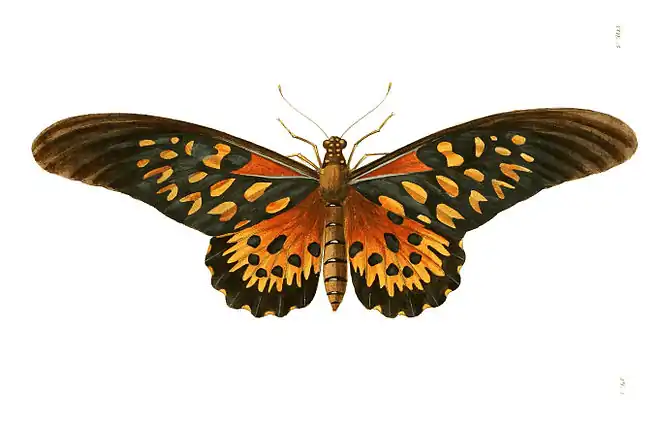
PAPILIO ANTIMACHUS.
Plate I.
Genus. Papilio, Linn. (Section Equit. Troj.) &c.
Papilio Antimachus. Alis nigris, anticis elongatis maculis fulvis, posticis subdentatis disco radiato rufo, nigro punctato; apice nigro lunulis marginalibus fulvis. (Expans. Alar. 8½ unc.)
Syn. Papilio Antimachus, Drury, App. vol. 3. Fabr. Ent. Syst. 3. pt. 1. p. 11. No. 31. Donov. Nat. Repos. pl. 100. & 101. God. and Latr. Enc. Méth. ix. p. 28. No. 8. Esper. Aus. Schm. t. 22. f. 2. Boisd. Hist. Nat. Lep. 1. p. 188.
Habitat: Sierra Leone (Drury).This magnificent butterfly is so exceedingly rare that M. Boisduval, whose knowledge of the European Collections is very extensive, questions whether there exists any other specimen than that originally figured by Drury. Mr. Jones also, whose splendid Collection of Drawings are so frequently quoted by Fabricius, copied this insect, figuring both the upper and under sides, which figures have been lately published by Mr. Donovan in his Naturalist's Repository. Mr. Donovan also adds, that from the manuscripts of Mr. Drury, "we find that he received this insect in 1775, from Mr. Smeathman, an assiduous and very intelligent naturalist stationed at Sierra Leone."
"From the observations of Mr. Smeathman it may be imagined that this insect is not unfrequent in that particular part of Africa, but that its capture is attended with considerable difficulty, as well from the manner of its flight, as the time when it appears on the wing; it is seen only in mid-day, when every exertion under the direct influence of a vertical sun must be painful to an European. Its flight is also remarkable for its velocity, and to increase the difficulty of taking it, the insect frequents only the upper branches of the trees, from whence it darts and glances from one branch to another, and never descends nearer to the ground than the height of eight feet. Mr. Smeathman observes also, that it turns its head about instantly to the glade or path, and will not suffer any person to approach within 'striking distance' of it, but will dart away on the least motion of the body; if the naturalist however exerts his patience, it will at last become more familiar and careless, and is then to be caught upon some particular branch, to which it will appear more attached than to another."
Mr. Donovan however suggests, that the insect must be not only exceedingly local, but also of great rarity.
PLATE II.
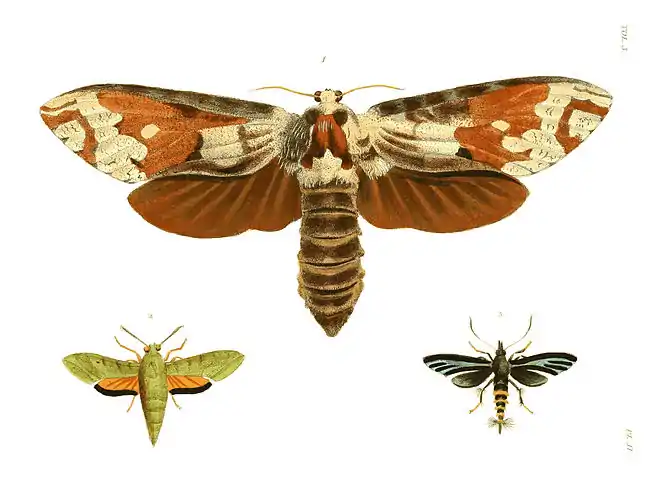
HEPIALUS CRASSUS.
Plate II. fig. 1.
Genus. Hepialus, Fabr. Hepiolus, Illiger. Phalæna (Noctua), Drury.
Hepialus Crassus. Alis anticis albis, fusco, cinereo, badioque variis, apice irregulariter albo, lunulâ magnâ fuscâ; posticis griseo-fuscantibus. (Expans. Alar. 7 unc.)
Syn. Phalæna (Noctua) crassa, Drury, App. vol. 3.
Habitat: Sierra Leone.
SPHINX IDRIEUS.
Plate II. fig. 2.
Genus. Sphinx, Linn.
Sphinx Idrieus. Corpore alisque anticis viridibus, posticis fulvis margine nigro. (Expans. Alar. 2 unc.)
Syn. Sphinx Idrieus, Drury, App. vol. 3. (1783.)
Sphinx Medea, Fabr. Ent. Syst. III. 1. p. 363. No. 23. (1793.)
Habitat: Africa (Drury). "Africa æquinoctiali" (Fabr.).
ÆGERIA? PLUMIPES.
Plate II. fig. 3.
Genus. Ægeria, Fabr.? Sesia, Latr. Sphinx, Drury.
Ægeria? Plumipes. Alis cyaneis, abdomine fulvo-cingulato, apice barbato; pedibus fulvis, femorum posticorum apice plumoso. (Expans. Alar. 1 unc. 9 lin.)
Syn. Sphinx plumipes, Drury, App. vol. 3.
Habitat: Africa.
PLATE III.
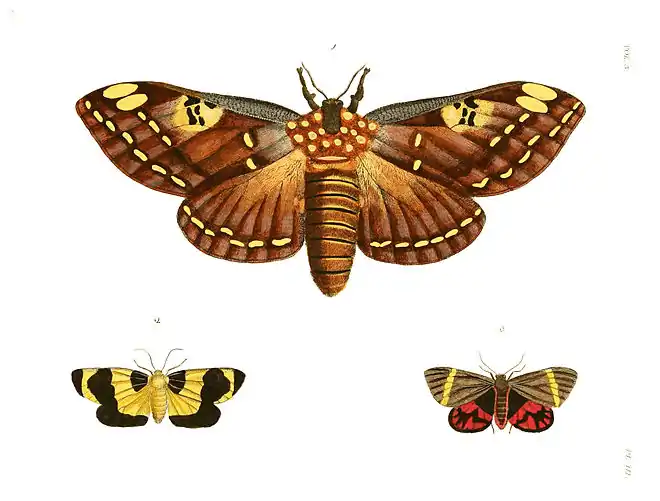
COSSUS LAOCOON.
Plate III. fig. 1.
Genus. Cossus, Fabr. Phalæna (Bombyx), Linn.
Cossus Laocoon. Alis rufo-badiis, apice obscurioribus maculâ mediâ albidâ, nigro punctatâ, lunulisque submarginalibus pallidis. (Expans. Alar. 6 unc. 3 lin.)
Syn. Phalæna (Attacus) Laocoon, Drury. Cramer, pl. 117. B.?
Habitat: Rio Janeiro, Brazil.
ARCTIA? MENEA.
Plate III. fig. 2.
Genus. Arctia? Schrank. Callimorpha, Latr.? Phalæna (Noctua), Drury.
Arctia? Menea. Flava, alis anticis basi, fasciâ latâ mediâ apiceque margineque postico posticarum nigris. (Expans. Alar. 2 unc.)
Syn. Phalæna (Noctua) Menea, Drury, App. vol. 3.
Habitat: Brazil.
CALLIMORPHA? MOPSA.
Plate III. fig. 3.
Genus. Callimorpha? Latr. Phalæna (Noctua), Drury.
Callimorpha? Mopsa. Alis anticis fuscis fasciâ rectâ subapicali; posticis sanguineis, basi, fasciâ mediâ undatâ margineque nigris. (Expans. Alar. 1 unc. 9 lin.)
Syn. Phalæna (Noctua) Mopsa, Drury, App. vol. 2.
Habitat: Madras.
PLATE IV.
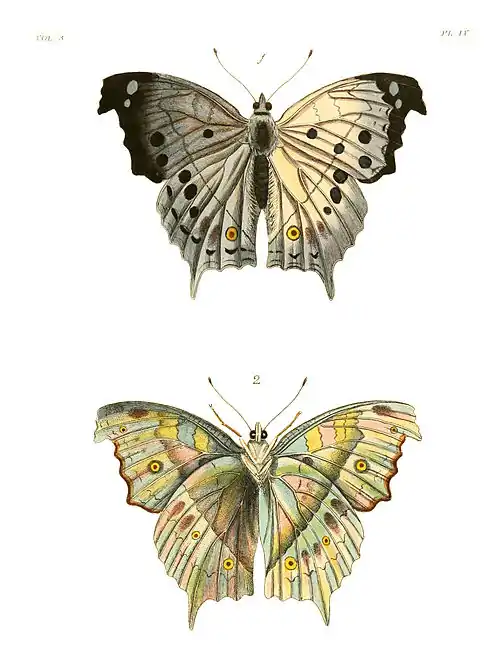
VANESSA ANACARDII.
Plate IV. fig. 1, 2.
Genus. Vanessa, Fabricius, Latr. God. Hamadryades, Hübn. Papilio (Nymph. Gemmat.) Drury. (Dan. Cand.) Linn.
Vanessa Anacardii. Alis subdentatis; suprà margaritaceis extimumque versùs nigro punctatis, anticis falcatis, posticis extùs caudatis ocelloque ad angulum ani notatis. (Expans. Alar. 3 unc. 9 lin.)
Syn. Papilio (Dan. Cand.) Anacardii, Linn. Syst. Nat. 11. 758. No. 74.? Fabr. Ent. Syst. 1. p. 183. 567.?
Papilio (Nymph. Gemm.) Parrhasius, Drury, App. vol. 3.
Papilio Æthiops, Pal. Beauv. Lep. pl. 3. fig. 1. 2.
Papillon Opale, Pal. Beauv. texte. p. 22.
Vanessa Aglatonice, Latr. God. Enc. Méth. ix. p. 299. 8.
Habitat: Sierra Leone (Drury). "In Anacardio Americes," (Linn.) an recte?Linnæus appears to have confounded this African insect with an American butterfly, figured by Mad. Merian, giving the name to the African species, with the additional habits of the American one. The copy of Drury's work, which belonged to Linnæus, late in the library of Sir J. E. Smith (by whom the collections of the great Swede were purchased), and now in that of the Linnæan Society, contains a pencil note, by its late possessor, of reference of this figure to the Anacardii of Linnæus.
PLATE V.
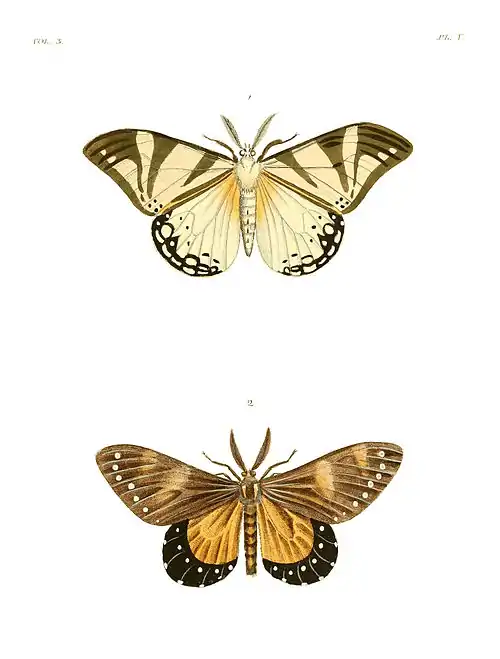
CALLIMORPHA? CAFRA.
Plate V. fig. 1.
Genus. Callimorpha? Latr. Phalæna (Noctua), Drury.
Callimorpha? Cafra. Alis albis, anticis strigis duabus transversis, unâ humerali alterâ mediâ, apiceque marginali nigricantibus, posticis lunulis punctisque submarginalibus atris. (Expans. Alar. 4 unc.)
Syn. Phalæna (Bombyx) Cafra, Drury, App. vol. 3.
Habitat: Sierra Leone.
CALLIMORPHA? NERINA.
Plate V. fig. 2.
Genus. Callimorpha? Latr. Phalæna (Noctua), Drury.
Callimorpha? Nerina. Alis anticis nigris, nervis basalibus luteis, fasciis duabus punctisque submarginalibus albidis, posticis fulvo-brunneis apice nigro, punctis submarginalibus albis. (Expans. Alar. 3 unc. 6 lin.)
Syn. Phalæna (Bombyx) Nerina, Drury, App. vol. 3.
Habitat: Sierra Leone.
PLATE VI.
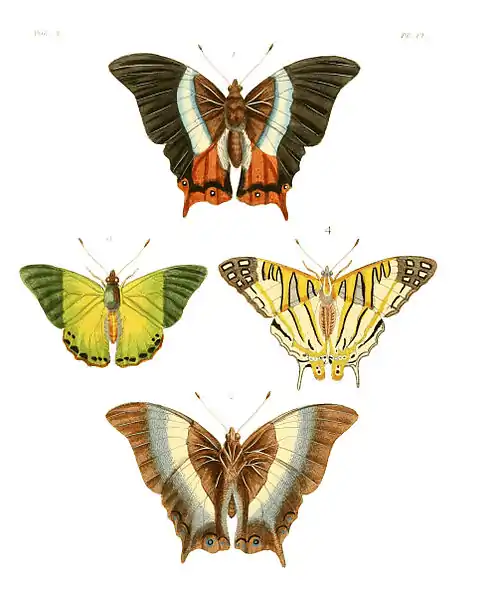
NYMPHALIS DECIUS.
Plate VI. fig. 1, 2.
Genus. Nymphalis, Latr. Papilio (Nymph. Gemmat.), Drury.
Nymphalis Decius. Alis supra fuscis, fasciâ communi albâ; posticis caudatis, ad angulum ani rufis ocellis duobus. (Expans. Alar. 3 unc. 3 lin.)
Syn. Papilio Decius, Cram. pl. 114. A. B. Fabr. Ent. Syst. III. 1. p. 67. No. 210. Herbst. tab. 56. f. 112. Nymphalis D., Enc. Méth. ix. p. 363. Donovan Nat. Repos. 4. 109.
Habitat: Sierra Leone (Drury). Interior, near the Gold Coast (Donovan).Mr. Smeathman states that this species was taken at a considerable distance from the coast, and that it is exceedingly scarce.
NYMPHALIS EUPALE.
Plate VI. fig. 3.
Genus. Nymphalis, Latr. Papilio (Nymph. Gemmat.), Drury.
Nymphalis Eupale. Alis supra argenteo-virescentibus, apice saturatiore, subtùs gramineis, punctis marginalibus nigris ocellatis. (Expans. Alar. 2 unc. 6 lin.)
Syn. Papilio (Pleb. Urbic.) Eupale, Drury, App. vol. 3. (1783.)
Papilio (Nymph.) Amasia, Fabr. Ent. Syst. III. 1. p. 136. No. 419. (1793). Encyclop. Méth. ix. p. 389. (Nymphalis A.)
Habitat: Sierra Leone.Mr. Smeathman states, that this species was obtained at a considerable distance from the coast, and that it is frequently seen in company with the groups of Nymph. Erithonius described in vol. ii. pl. 15. fig. 1.
NYMPHALIS CAMILLUS.
Plate VI. fig. 4.
Genus. Nymphalis, Latr. Papilio (Nymph. Gemmat.), Drury.
Nymphalis Camillus. Alis albis, fasciis fulvis nigro-marginatis, posticis bicaudatis angulo ani fulvo, punctis nigris albo marginatis. (Expans. Alar. 2 unc. 9 lin.)
Syn. Papilio N. Camillus, Fabr. Spec. Ins. tom. 2. p. 11. No. 42. (1781). Enc. Méth. ix. p. 361. No. 39. (Nymphalis C.)
Papilio (Eq. Ach.) Pantheus, Drury, App. vol. 2. (1783.)
Habitat: Sierra Leone.
PLATE VII.
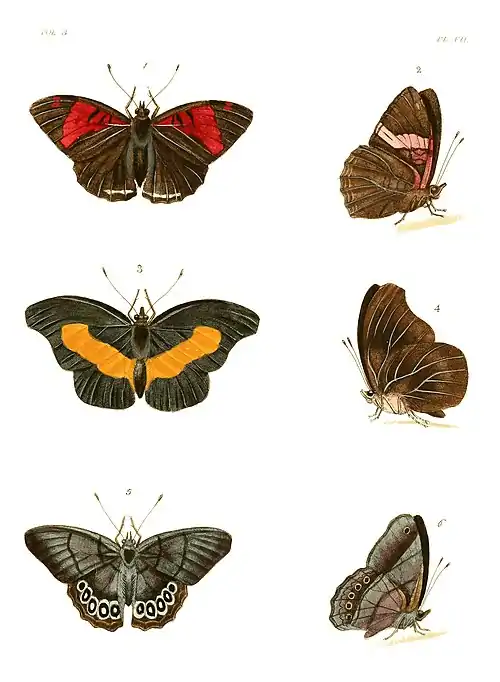
NYMPHALIS ISIS.
Plate VII. fig. 1, 2.
Genus. Nymphalis, Latr. Papilio (Nymph. Gemmat.), Drury.
Nymphalis Isis. Alis fusco-nigris, anticis integris utrinque maculâ disci chermesinâ; posticis dentatis, suprà strigâ marginali albidâ. (Expans. Alar. 2 unc. 6 lin.)
Syn. Papilio (Dan. Fest.) Isis, Drury, App. vol. 3. (1783.)
Papilio N. Isis, Fabr. Ent. Syst. III. 1. p. 124. No. 377. (1793.) Donovan Ins. India, pl. 7. fig. 1. 2.
Habitat: Rio Janeiro.It is by mistake that Donovan has introduced this Brazilian species into his work upon the Insects of India.
NYMPHALIS ANTIOCHUS.
Plate VII. fig. 3, 4.
Genus. Nymphalis, Latr. Papilio (Nymph. Gemmat.), Drury.
Nymphalis Antiochus. Alis supra holosericeo-nigris, fasciâ communi nitidè aurantiâ; anticarum abbreviatâ. (Expans. Alar. 2 unc. 9 lin.)
Syn. Papilio (Dan. Fest.) Antiochus, Linn. Mant. 1. 537. Drury, App. vol. 3. Fabricius Ent. Syst. III. 1. p. 44. No. 134. Don. Ins. China, pl.
Papilio Eupalemon, Cramer, tab. 143. fig. B. C. Le Velonté Daubenton pl. Eulum. 68. f. 3. 4.
Habitat: Brazil.Donovan has, in like manner, introduced this species into his work on the insects of China.
HIPPARCHIA CLUENA.
Plate VII. fig. 5, 6.
Genus. Hipparchia, Fabr. Satyrus, Latr. Papilio (Nymph. Phal.), Drury.
Hipparchia Cluena. Alis teneris, cinerascenti-violaceis, posticis dentatis utrinque ocellis quinque atris, subtùs lineis tribus fasciâque brunneis a costâ anticarum deductis. (Expans. Alar. 2 unc. 3 lin.)
Syn. Papilio (Nymph. Phal.) Cluena, Drury, App. vol. 3.
Papilio (Satyrus) Clueria, Fabr. Ent. Syst. III. 1. p. 229. No. 716. Enc. Méth. ix. p. 492.
Habitat: Brazil. "Rio Janeiro, Mr. Bonifas, 1775" (Drury's MSS.).
PLATE VIII.
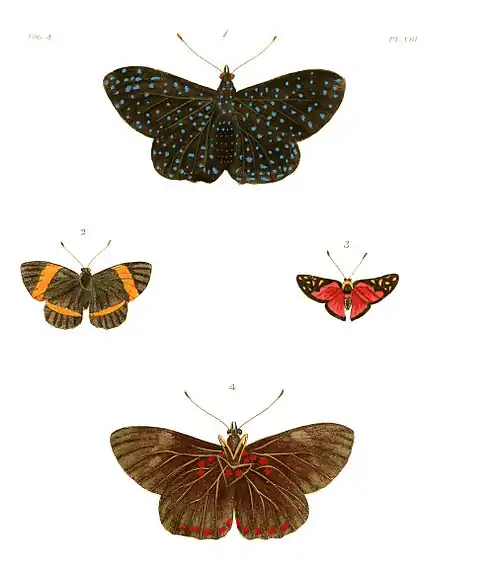
NYMPHALIS ARETHUSA.
Plate VIII. fig. 1, 4.
Genus. Nymphalis, Latr. Papilio (Nymph. Gemmat.), Drury.
Nymphalis Arethusa. Alis integris suprà nitidè atris, virescenti-cœruleo multimaculatis; posticis subtùs punctis baseos angulique ani rubris ♂. (Expans. Alar. 3 unc. 3 lin.)
Syn. Papilio Arethusa, Cramer, pl. 77. E. F. (♂.) pl. 130. fig. A. (♀ Pap. Laodamia.) Fabr. Ent. Syst. III. 1. p. 43. No. 130.
Nymphalis Arethusus. Enc. Méth. ix. p. 427. Donovan Nat. Repos. 2. pl. 48. fig. super.
Habitat: Brazil.
ERYCINA JARBAS.
Plate VIII. fig. 2.
Genus. Erycina, Fabr. Latr. God. Papilio (Dan. Fest.), Drury.
Erycina Jarbas. Alis integerrimis atris, cœruleo micantibus singulis utrinque fasciâ fulvâ, transversali, mediâ. (Expans. Alar. 1 unc. 9 lin.)
Syn. Papilio (Dan. Fest.) Jarbas, Drury, App. vol. 3. (1783.)
Hesperia (rur.) Perditus, Fabr. Ent. Syst. III. 1. p. 323. No. 222.
Erycina Perditus, Enc. Méth. ix. p. 590. No. 127.
Habitat: Brazil. "Rio Janeiro, Mr. Bonifas, 1775" (Drury's MSS.).
ERYCINA MENETAS.
Plate VIII. fig. 3.
Genus. Erycina, Fabr. Latr. God. Papilio (Dan. Fest.), Drury.
Erycina Menetas. Alis chermesinis, limbo tenuissimo nigro, margine antico et externo anticarum latiori, flavoque maculato, posticis triangularibus. (Expans. Alar. 1 unc. 3 lin.)
Syn. Papilio (Pleb. urb.) Menetas, Drury, App. vol. 3. (1783.)
Hesperia R. Tacitus, Fabr. Ent. Syst. III. 1. p. 308. 168. (1793.)
Erycina Tacitus, Enc. Méth. ix. p. 588. Donovan Nat. Reposit. 4. 134.
Habitat: "Brazil, Mr. Bonifas, 1776" (Drury's MSS.). Surinam (Fabricius).Mr. Donovan has lately published figures of the upper and under side of this butterfly (which closely resemble each other) in his Naturalist's Repository. These figures do not however represent the peculiar character of the posterior pair of wings, neither is the author correct in his chronological account of this species, as Drury's account and figure were published ten years previous to the Entomologia Systematica, in which work alone of Fabricius is the species mentioned. I have consequently retained the specific designation imposed by Drury, and adopted by the authors of the Encyclopédie Méthodique.
PLATE IX.
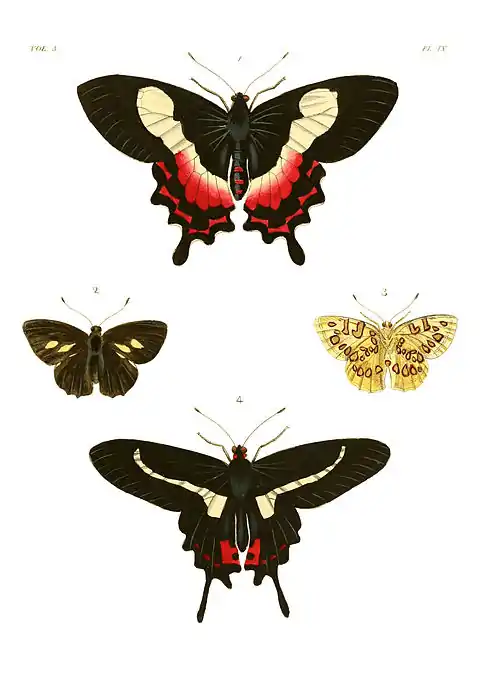
PAPILIO ASCANIUS.
Plate IX. fig. 1.
Genus. Papilio, Auct. Papilio (Equit. Troj.), Linn.
Papilio Ascanius. Alis nigris, fasciâ communi albâ, posticarum rubro inquinatâ; his caudatis, maculis marginalibus chermesinis. (Expans. Alar. 4 unc.)
Syn. Papilio Ascanius, Cramer, pl. 14. fig. A. Fabricius Spec. Ins. tom. 2. p. 2. No. 6. Ent. Syst. III. 1. p. 3. No. 8. Enc. Méth. ix. p. 73. Boisduval Hist. Nat. Lepid. 1. 306. 141.
Habitat: Brazil. "Rio Janeiro, Mr. Bonifas, 1775" (Drury's MSS.).
ERYCINA AMPYX.
Plate IX. fig. 2, 3.
Genus. Erycina, Fabr. Latr. God. Papilio (Dan. Fest.), Drury.
Erycina Ampyx. Alis subintegris supra fuscis, anticarum maculis duabus flavis; subtus omnibus flavis, maculis ferrugineis auro-pupillatis. (Expans. Alar. 1 unc. 9 lin.)
Syn. Papilio (Pl. urb.) Ampyx, Drury, App. vol. 3.
Erycina Ampyx, Latr. & God. Enc. Méth. ix. p. 586. No. 105.
Habitat: Brazil. "Rio Janeiro, Mr. Bonifas, 1776" (Drury's MSS.).
PAPILIO AGAVUS.
Plate IX. fig. 4.
Genus. Papilio, Auct. Papilio (Equit. Troj.), Linn.
Papilio Agavus. Alis atris concoloribus; anticis fasciâ, posticis disco, albidis; his caudatis lunulis marginalibus anguloque anali chermesinis. (Expans. Alar. 3 unc. 6 lin.)
Syn. Papilio (Eq. Achiv.) Agavus, Drury, App. vol. 3. Stoll. Suppl. Cram. pl. 32. 1. 1. A. Latr. & God. Enc. Méth. ix. p. 73. Boisd. Hist. Nat. Lep. 1. p. 306. 142.
Papilio Lysander? Fabr. Ent. Syst. III. 1. p. 9.
Habitat: Brazil.
PLATE X.
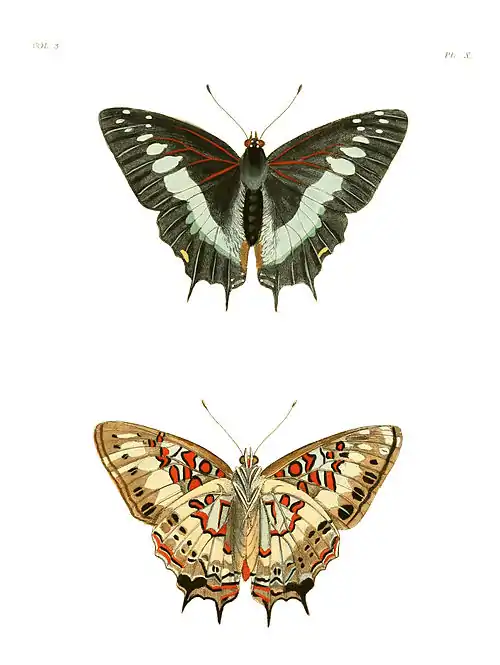
NYMPHALIS (CHARAXES) ETESIPE.
Plate X.
Genus. Nymphalis, Latr. Papilio (Eq. achiv.) Linn. Drury. Papilio Nymphalis, Fabr. (Subgenus: Charaxes, Boisduval.)
Nymphalis (Charaxes) Etesipe. Alis supra atro-cœruleis, subtus albo griseo nigro ferrugineoque marmoratis; utrinque fasciâ albâ, mediâ, anticarum interruptâ. (Expans. Alar. 3 unc. 6 lin.)
Syn. Nymphalis Etesipe, Latr. & God. Enc. Méth. ix. p. 355. No. 19.
Papilio (Nymph. Phal.) Etheocles, Drury, App. vol. 3. (nec Fabricius.)
Habitat: "Sierra Leone, Mr. Smeathman, 1775" (Drury's MSS.).The name of Etheocles, which Drury applied to this insect, without any reference to Fabricius, had been previously employed by that author for a distinct but nearly allied species, which he indeed regarded as identical with Drury's insect. The distinctions between the two species were first pointed out in the Encyclopédie Méthodique, in which work the name adopted above was given to Drury's insect.
PLATE XI.
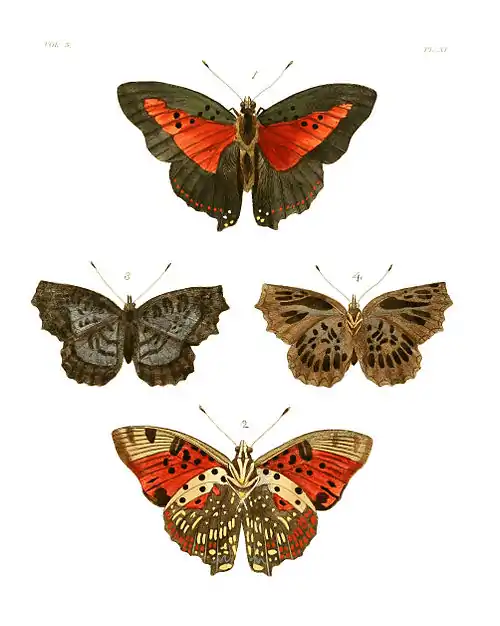
NYMPHALIS (CHARAXES) BERENICE.
Plate XI. fig. 1, 2.
Genus. Nymphalis, Latr. Papilio (Eq. achiv.) Linn. Drury. Papilio Nymphalis, Fabr. (Subgenus: Charaxes, Boisduval.)
Nymphalis (Charaxes) Berenice. Alis supra nigris, fasciâ communi rufâ, disco nigro maculato; posticis subtus albo, flavo ferrugineoque maculatis. (Expans. Alar. 3 unc. 3 lin.)
Syn. Papilio (Nymph. Phal.) Berenice, Drury, App. vol. 3. (1783.) Fabr. Mant. Ins. 2. p. 48. No. 471. (1787.)
Papilio Zingha, Cramer, pl. 315. fig. B. C. Herbst. t. 151. fig. 3. 4. Donovan Nat. Repos. 3. 107.
Habitat: "Sierra Leone, Mr. Smeathman, 1776" (Drury's MSS.).
BIBLIS ARIADNE?
Plate XI. fig. 3, 4.
Genus. Biblis, Fabr. Latr. God.
Biblis Ariadne? Alis denticulatis, anticarum apice truncato, griseis, strigis nigris undulatis; subtus rufescenti-fuscis nigro variis, anticis apice puncto costali albo. (Expans. Alar. 2 unc. 5 lin.)
Syn. Papilio (Nymph.) Ariadne, Linn. Syst. Nat. 2. 778? Fabr. Ent. Syst. III. 1. p. 383.?
Papilio Coryta, Cramer, pl. 86. E. F.
Papilio Merione, Cramer, pl. 144. G. H.?
Biblis Ariadne, Enc. Méth. ix. 327.
Habitat: Coromandel, Java (Enc. Méth.). "Sierra Leone, Mr. Smeathman, 1776" (Drury's MSS.).Drury refers this insect to the Linnæan Ariadne, which is from Java. It is therefore with doubt that I give it the preceding synonyms, especially as Lepidopterists have neglected to cite Drury's figures.
PLATE XII.
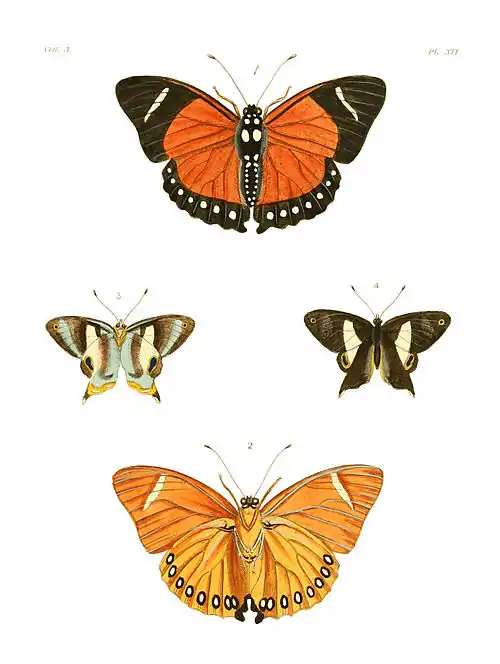
NYMPHALIS ELEUS.
Plate XII. fig. 1, 2.
Genus. Nymphalis, Latr. Papilio (Nymph. Gemmat.), Drury.
Nymphalis Eleus. Alis utrinque testaceis, apice suprà æneo, anticarum fasciâ, posticarum punctis in simplici serie, albis. (Expans. Alar. 3 unc. 6 lin.)
Syn. Papilio (Nymph. Phal.) Eleus, Drury, App. vol. 3. Fabr. Ent. Syst. III. 1. p. 51. No. 156. Encycl. Méth. ix. 391.
Nymphalis Eleus, Donovan Natur. Repos. 4. 113.
Habitat: "Sierra Leone, Mr. Smeathman, 1774" (Drury's MSS.). "America" (Fabricius incorrectly).Mr. Donovan has satisfactorily proved, from information derived both from Jones and Drury's MSS., that Fabricius erroneously gave America as the habitat of this insect.
ERYCINA BAUCIS.
Plate XII. fig. 3, 4.
Genus. Erycina, Fabr. Latr. God. Papilio (Pleb. rur.), Drury.
Erycina Baucis. Alis anticis fuscis, ocello minuto apicali, fasciâ communi abbreviatâ albâ, posticis caudatis ocello auriformi externo. (Expans. Alar. 1 unc. 9 lin.)
Syn. Papilio (Pleb. rur.) Baucis, Drury, App. vol. 3.
Habitat: "Sierra Leone, Mr. Smeathman, 1775" (Drury's MSS.).
PLATE XIII.
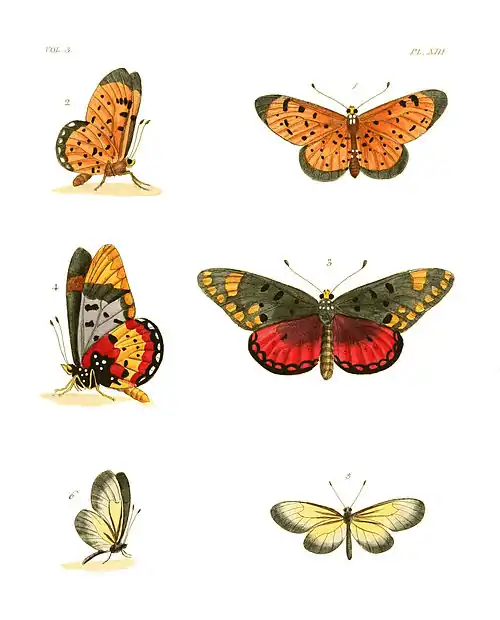
ACRÆA HYPATIA.
Plate XIII. fig. 1, 2.
Genus. Acræa, Fabr. Latr. God. Papilio (Helicon.), Drury.
Acræa Hypatia. Alis oblongis integerrimis fulvis, punctis plurimis margineque externo nigris, posticarum eodem margine supra immaculato, subtus flavo maculato. (Expans. Alar. 2 unc. 6 lin.)
Syn. Papilio (Helic.) Hypatia, Drury, App. vol. 3. Fabr. Ent. Syst. III. 1. p. 163. No. 504. Enc. Méth. ix. p. 232. (Acræa H.)
Habitat: "Sierra Leone, Mr. Smeathman, 1776" (Drury's MSS.).According to Mr. Smeathman, this butterfly and that represented in figures 3 and 4 of this plate, and indeed all the "Heliconii," are found in great numbers in those places where they breed, and are observed to bask and sport as much as possible in the sunshine, retiring towards sunset in great crowds to particular bushes. They breed chiefly in recent plantations, and near towns in general, so that, comparatively speaking, few of them are found in the ancient forests. Such however as inhabit them fly about the tops of the highest trees, seeking the honey from their flowers, and are seldom seen below.
ACRÆA MENIPPE.
Plate XIII. fig. 3, 4.
Genus. Acræa, Fabr. Latr. God. Papilio (Helicon.), Drury.
Acræa Menippe. Alis oblongis integerrimis, anticis suprà fuscis nigro-punctatis; ad apicem fasciâ abbreviatâ maculisque marginalibus albidis; posticis fasciâ fulvâ latâ transversâ. (Expans. Alar. 3 unc. 3 lin.)
Syn. Papilio (Helic.) Menippe, Drury, App. vol. 3. Stoll. Suppl. Cram. pl. 28. fig. 1. Herbst. tab. 81. f. 4. 5.
Papilio H. Zetes? Linn. Syst. Nat. 2. 766. No. 110.
Acræa Zethea, Enc. Méth. ix. p. 236.
Habitat: Sierra Leone, and other parts of the Western Coast of Africa.This insect has been regarded as the Zetes of Linnæus; it does not appear however to agree with the Linnæan description, in which the anterior wings are said to be "nebulosis, punctatis:" nor with the habitat "in Indiis" given of that species.
HELICONIA GAZORIA.
Plate XIII. fig. 5, 6.
Genus. Heliconia, Fabr. Latr. God. Papilio (Helicon.), Linn. &c.
Heliconia Gazoria. Alis oblongis integerrimis, dimidiatim flavis hyalinisque margine exteriori fusco, posticis subtus (♀) maculâ baseos aurantiacâ. (Expans. Alar. 2 unc.)
Syn. Heliconia Gazoria, Latr. & God. Enc. Méth. ix. p. 214. No. 35.
Papilio (Hel.) Euritæa, Drury, App. vol. 3. (exclus. Syn. Crameri.)
Habitat: Rio Janeiro, Brazil.
PLATE XIV.
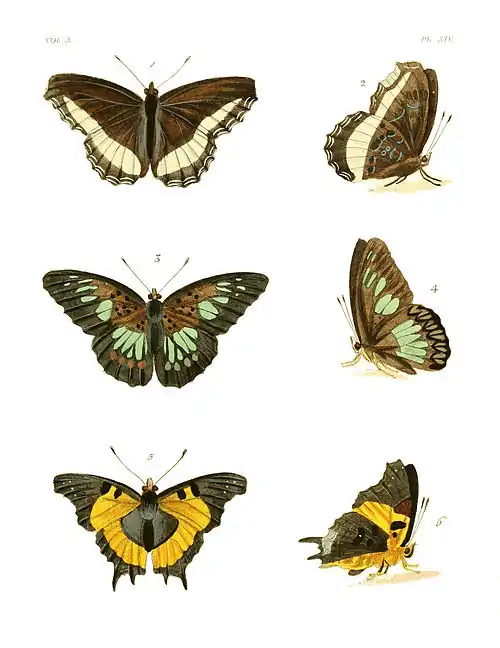
BIBLIS HIARBAS.
Plate XIV. fig. 1, 2.
Genus. Biblis, Fabr. Latr. God. Papilio (Nymphal. Phal.), Drury.
Biblis Hiarbas. Alis dentatis, fuscis; fasciâ utrinque communi albâ, posticarum latiore, anticarum abbreviatâ. (Expans. Alar. 2 unc. 6 lin.)
Syn. Papilio (Nymph. Ph.) Hiarbas, Drury, App. vol. 3. Donovan Ins. India, pl. 3. fig. 3. Fabr. Ent. Syst. III. 1. p. 128. No. 391.
Biblis Hiarba, Enc. Méth. ix. p. 824. 2.
Habitat: Sierra Leone (Drury). Cape of Good Hope (J. O. W.).Fabricius cites Drury's collection alone for this species, incorrectly giving India as its habitat. Drury had previously stated it to have been received from Sierra Leone. Donovan, relying upon the former rather than the latter, figured the insect in his "Epitome of the Insects of India."
NYMPHALIS SEMIRE.
Plate XIV. fig. 3, 4.
Genus. Nymphalis, Latr. Papilio (Nymph. Gemmat.), Drury.
Nymphalis Semire. Alis subdentatis fuscis, fasciâ utrinque viridi interruptâ, posticis ad angulum ani ferrugineo maculatis; subtus omnibus basi luteis, nigro punctatis. (Expans. Alar. 2 unc. 9 lin.)
Syn. Papilio (N.) Semire, Fabr. Spec. Ins. tom. 2. p. 88. Ent. Syst. III. 1. p. 114. No. 351. Cramer, pl. 194. fig. B. C.
Papilio (N. Ph.) Hippolyte, Drury, App. vol. 3.
Nymphalis Semire, Latr. & God. Enc. Méth. ix. p. 392.
Habitat: Sierra Leone.
VANESSA DELIUS.
Plate XIV. fig. 5, 6.
Genus. Vanessa, Fabr. Latr. God. Hamadryades, Hübn. Papilio (Nymph. Phal.) Drury.
Vanessa Delius. Alis dentatis suprà fulvis basi extimoque fuscis, anticis apice strigâ punctorum alborum; posticis maculâ discoidali oblongâ ocellisque duobus analibus nigris, his extus caudatis, illis falcatis. (Expans. Alar. 2 unc. 5 lin.)
Syn. Papilio (Nymph. Phal.) Delius, App. vol. 3. (1783.)
Papilio N. Eurocilia, Fabr. Ent. Syst. III. 1. p. 79. No. 247. (1793.)
Vanessa Demonica, Latr. & God. Enc. Méth. ix. p. 301. No. 14. (1819.)
Habitat: Sierra Leone, with the two preceding (Drury). "In Indiis" (Fabr.). America? (Enc. Méth.).The locality given by our author is evidently correct, because he was furnished with information respecting its habits by Mr. Smeathman, who stated that it breeds chiefly near open and cultivated spots, or in recent plantations, and sports in the sun like the Acrææ.
PLATE XV.
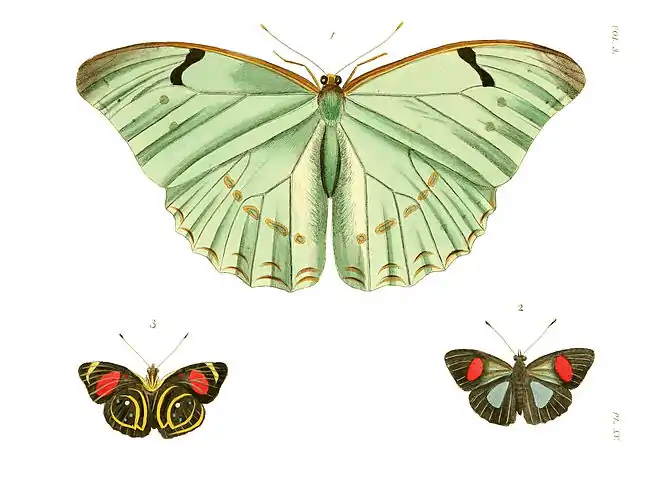
MORPHO LAERTES.
Plate XV. fig. 1.
Genus. Morpho, Fabr. Latr. God. Papilio (Equit. Achiv.), Drury.
Morpho Laertes. Alis subdentatis, utrinque margaritaceo-albis, anticarum fasciâ costali nigrâ, posticis subtus strigâ ocellorum lunulisque marginalibus. (Expans. Alar. 6 unc. 3 lin.)
Syn. Papilio (Eq. Achiv.) Laertes, Drury, App. vol. 3. Esper Pap. Exot. tab. 43. f. 2. Fabr. Ent. Syst. III. 1. p. 84. No. 262. Enc. Méth. ix. p. 444. (Morpho L.)
Papilio Epistrophus, Fabr. Ind. Alphab. to Ent. Syst. p. 124. Donovan Nat. Repos. 4. 143.
Habitat: Brazil.Fabricius, in the Entomologia Systematica, described two butterflies under the name of Papilio (N.) Laertes, No. 226. from Surinam figured by Cramer, and No. 262, from South America, figured by Drury. As the former species had the priority in point of date, Fabricius, in the alphabetical index to that work, altered the name of Drury's insect to Epistrophus. By the establishment, however, of the genus Morpho, comprising the insect figured by Drury, the difficulty is obviated, and as the species is universally known under the name of Laertes, it does not appear requisite to adopt the name of Epistrophus.
NYMPHALIS (CATAGRAMMA) HYDASPES.
Plate XV. fig. 2, 3.
Genus. Nymphalis, Latr. God. Papilio (Nymphalis), Fabr. Subgenus: Catagramma, Boisduval.
Nymphalis (Catagramma) Hydaspes. Alis subdentatis, nigris, basi suprà nitidè cyaneis, anticis utrinque fasciâ chermesinâ abbreviatâ; posticis subtùs annulis duobus flavis punctisque quatuor ocellaribus. (Expans. Alar. 1 unc. 10 lin.)
Syn. Papilio (Pleb. rur.) Hydaspes, Fabr. MSS. cited by Drury, App. vol. 3. (1783.) nec Fabr. Ent. Syst. III. 1. p. 54. No. 167. (1793.)
Nymphalis Hydaspes, Latr. & God. Enc. Méth. ix. p. 424. (nec Cat. Hydaspes, Boisd. Hist. Nat. Lep. 1. pl. 9. f. 2., Donovan Nat. Repos. vol. 2. pl. 60.)
Biblis Hesperia, Perty Delect. Anim. art. Bras. pl. 30. f. 4. a. b.
Habitat: Brazil.Drury referred this insect to the then unpublished Papilio Hydaspes, on the authority of Fabricius's handwriting, (his specimen having most probably been thus labelled by that author.) The authors of the Encyclopédie Méthodique also cite Drury's figure under Hydaspes. Fabricius, however, cites only the Banksian Cabinet, and Mr. Donovan's figure taken from the Banksian specimen, and published in the Naturalist's Repository, Vol. 2. Pl. 60. convinces us that Drury's insect is specifically distinct from that described by Fabricius, although evidently identical with the insect described as Hydaspes in the Encyclopédie Méthodique. Under these circumstances I have considered it most advisable to retain the name of Hydaspes for Drury's insect, under which name it was known for the space of ten years before the publication of the Fabrician Hydaspes, to which a new specific name must be applied. As there are several other nearly allied Brazilian species, it is not impossible that Fabricius, from recollection alone, applied the name of Hydaspes to Drury's specimen, having previously described the insect from the Banksian Cabinet, the under surface of which especially is very different from that figured by Donovan.
PLATE XVI.
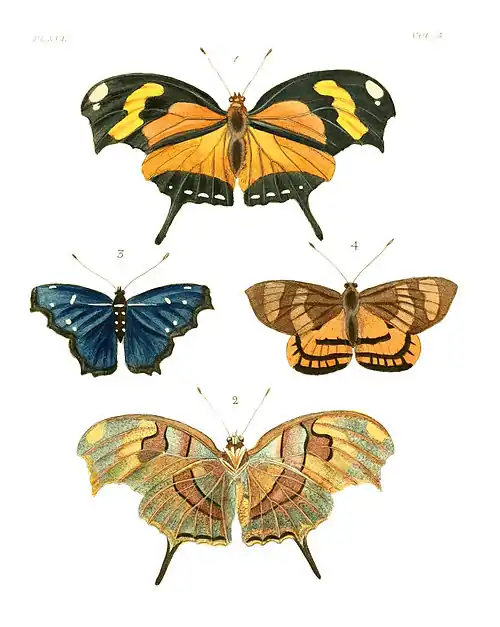
NYMPHALIS HIPPONA.
Plate XVI. fig. 1, 2.
Genus. Nymphalis, Latr. God. Papilio (Nymphalis), Fabr.
Nymphalis Hippona. Alis suprà nigris, anticis fulvo flavoque variis: posticis caudatis basi fulvo apice nigro strigâ marginali punctorum alborum. (Expans. Alar. 4 unc.)
Syn. Papilio (Nymph.) Hippona, Fabr. Sp. Ins. 2. p. 54. No. 258. Ent. Syst. III. 1. p. 180. No. 559. Donovan Ins. India, pl. 35. fig. * Encycl. Méth. ix. p. 362.
Papilio (Nymph. Phal.), Cramer, pl. 90. fig. C. D. Stoll Suppl. Cramer, pl. 2. fig. 1. & 1. A. B. C. Drury, App. vol. 3.
Habitat: Brazil (Drury). Guiana, Antilles (Enc. Méth.).The transformations of this curious species have been figured by Stoll in his supplementary volume to Cramer. The caterpillar is of a dark green, with a black dorsal line and lateral spots of the same colour. The head is black, with two yellow spots, and furnished with two short obtuse spines. It lives upon a plant called "poirvier," feeding only by night, remaining during the day concealed in a kind of case, which it forms by rolling up a leaf. The chrysalis is short, and thick, without angular prominences, of a grey colour, with black dots. It attaches itself by the tail to the stem of the plant upon which it feeds.
Fabricius erroneously gives India as the habitat of this species, whence Donovan has introduced it into his work upon the insects of that country.
NYMPHALIS ORSIS ♂.
Plate XVI. fig. 3.
Genus. Nymphalis, Latr. God. Papilio (Nymphalis), Fabr.
Nymphalis Orsis. Alis nigris, (in mare cœruleo-micantibus) strigis tribus macularibus albis, prima et secunda corpus secantibus. (Expans. Alar. 2 unc. 3 lin.)
Syn. Papilio (Nymph. Phal.) Orsis, Drury, App. vol. 3.
Papilio (N.) Oisis, Fabr. Ent. Syst. III. 1. p. 124. No. 378. (♂.) Enc. Méth. ix. p. 381. No. 102. (Nymphalis O.)
Papilio N. Blandina, Fabr. Ent. Syst. III. 1. p. 129. (♀.) Donovan Ins. India, No. 2. pl. 1. f. 3.
Habitat: Brazil (Drury, &c.). In Indiis (Fabr.). East India (Donovan, erroneously).
CASTNIA THAIS.
Plate XVI. fig. 4.
Genus. Castnia, Fabr. Latr. God. Dalm. Papilio (Dan. Festiv.), Drury.
Castnia Thais. Alis anticis supra fusco-viridibus, nitidis, basi fasciisque duabus carneo-griseis; posticis rubris fasciis duabus margineque nigris. (Expans. Alar. 2 unc. 6 lin.)
Syn. Papilio (Dan. Festiv.) Thais, Drury, App. vol. 3.
Castnia Thalaira, Latr. God. Enc. Méth. ix. p. 800. No. 14.
Habitat: Brazil.
PLATE XVII.
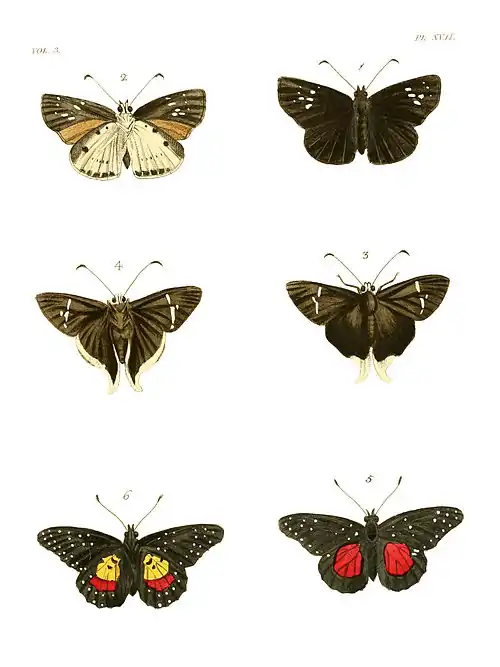
HESPERIA OPHION.
Plate XVII. fig. 1, 2.
Genus. Hesperia, Fabr. Latr. Erinnys P. Schr. Papilio (Pleb. Urb.), Drury.
Hesperia Ophion. Alis fuscantibus, anticis utrinque punctis quinque discoidalibus alterisque tribus subapicalibus albis; posticis subtùs albis margine antico nigro 3-maculato serieque punctorum submarginalium. (Expans. Alar. 1 unc. 10 lin.)
Syn. Papilio (Pleb. Urb.) Ophion, Drury, App. vol. 3. Stoll Suppl. Cram. pl. 26. f. 4.
Habitat: Sierra Leone.The African species of Hesperiidæ (according to Mr. Smeathman), including those represented in these and the two following figures, sport in the sun, and are remarkable for their very sudden and rapid short flights from bush to bush.
HESPERIA (EUDAMUS) ORION.
Plate XVII. fig. 3, 4.
Genus. Hesperia, Latr. Fabr. Thymele P. Fabr. (syst. Gl.) Heteropterus, Duméril. Subgenus: Eudamus, Swains. Boisd.
Hesperia (Eudamus) Orion. Alis nigro fuscis, anticis fasciâ tenui maculari subbifidâ punctisque subapicalibus; posticarum limbo externo caudisque albis. (Expans. Alar. 2 unc.)
Syn. Papilio Orion, Fabr. Mant. Ins. 2. p. 85. No. 774. Cramer, pl. 155. f. A. B. Drury, App. vol. 3.
Papilio (Pleb. Urb.) Proteus, var. β. Linn. Mus. Lud. Ulr. p. 333. Enc. Méth. ix. p. 729. No. 4. (Hesp. O.)
Eudamus Doryssus, Swains. Zool. Illustr. N. Ser. pl. 48.
Habitat: Sierra Leone (Drury, correctly?). Brazil, Surinam (Fabr. Enc. Méth. &c.).This insect belongs to the subgenus Eudamus proposed by Mr. Swainson, in the new series of his beautiful Zoological Illustrations, and appears in no respect to differ from that which he has figured under the name of Eudamus Doryssus. He observes that the type of this group is the Hesperia Proteus Fabr.; that all the species, of which there are nearly thirty, are from America; that their flight is exceedingly rapid in the morning and evening, and that they rest with their wings perpendicular. Drury, on the other hand, gives Sierra Leone as the habitat, and adds, moreover, on the authority of Mr. Smeathman, that this species, like the last, sports in the sun, and is remarkable for the very rapid short flights it takes from bush to bush, so as to be caught with great difficulty. In his manuscripts, however, I find this species marked as being from "Madras, Mr. Skeene, 1772."
NYMPHALIS JANAIS.
Plate XVII. fig. 5, 6.
Genus. Nymphalis, Latr. God. Papilio (Nymphalis), Fabr.
Nymphalis Janais. Alis subdentatis, nigris; anticis utrinque albo-punctatis; posticis supra disco rubro, subtus basi flavo et nigro, punctato. (Expans. Alar. 2 unc. 3 lin.)
Syn. Papilio (Nymph. Phal.) Janais, Drury, App. vol. 3.
Nymphalis J., Latr. et God. Enc. Méth. ix. p. 392. No. 146.
Habitat: "Sierra Leone" (Drury, in text). "Rio Janeiro, Mr. Bonifas, 1776" (Drury's MSS.).
PLATE XVIII.
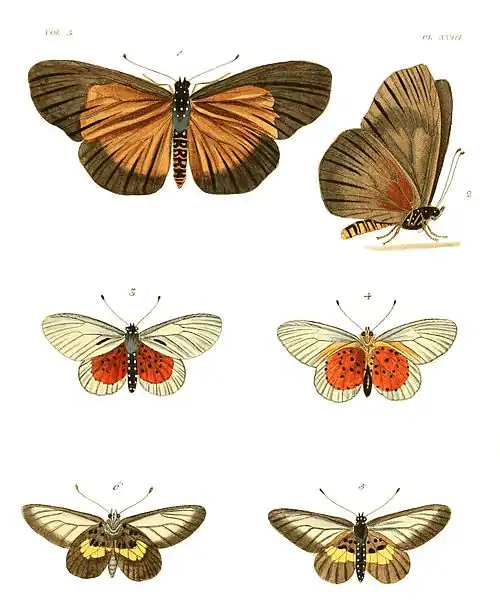
ACRÆA UMBRA.
Plate XVIII. fig. 1, 2.
Genus. Acræa, Fabr. Latr. God. Papilio (Heliconii), Fabr. olim.
Acræa Umbra. Alis oblongis integerrimis brunneis, extimo suprà latè fusco, posticis subtùs ad basin nigro punctatis. (Expans. Alar. 3 unc. 9 lin.)
Syn. Papilio (Dan. Fest.) Umbra, Drury, App. vol. 3.
Papilio (Hel. U.), Fabr. Ent. Syst. III. 1. p. 172. No. 535. Enc. Méth. ix. p. 236. (Acræa U.)
Habitat: Sierra Leone.
The minute black spots at the base of the posterior wings, described by Drury and Fabricius, are not represented in the figure.
ACRÆA DICE.
Plate XVIII. fig. 3, 4.
Genus. Acræa, Fabr. Latr. God. Papilio (Helicon.), Fabr. olim.
Acræa Dice. Alis oblongis integerrimis concoloribus, anticis hyalino-cinerascentibus; posticis fulvis nigro-punctatis, margine exteriori latè hyalino. (Expans. Alar. 2 unc. 1½ lin.)
Syn. Papilio (Helicon.) Dice, Drury, App. vol. 3. (1783.)
Papilio (H.) Quirina, Fabr. Ent. Syst. III. 1. p. 159. No. 492. (1793.) Enc. Méth. ix. p. 231. No. 2. (Acræa Q.)
Habitat: "Sierra Leone, Mr. Smeathman, 1776" (Drury's MSS.). Madras (Fabricius).
ACRÆA CIRCEIS.
Plate XVIII. fig. 5, 6.
Genus. Acræa, Fabr. Latr. God. Papilio (Heliconii), Fabr. olim.
Acræa Circeis. Alis oblongis integerrimis; anticis hyalinis, nervis margineque fuscis, posticis fuscis fasciâ flavescenti, transversâ mediâ, his subtus basi cinereis nigroque punctatis. (Expans. Alar. 2 unc.)
Syn. Papilio Circeis, Drury, App. vol. 3. Herbst. Pap. tab. 81. fig. 6. 7.
Papilio (Parnass.) Mandane, Fabr. Syst. Ent. III. 1. p. 183. No. 565. Encycl. Méth. ix. p. 239. 29. (Acræa M.)
Habitat: "Sierra Leone, Mr. Smeathman, 1775" (Drury's MSS.).Here, as in many places elsewhere, I have reverted to Drury's name, which Fabricius unwarrantably changed in the subsequently published Entomologia Systematica, and which in most cases the authors of the Encyclopédie Méthodique have adopted.
PLATE XIX.
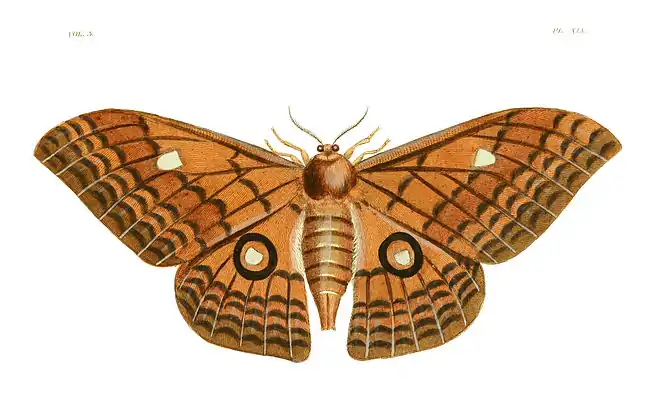
SATURNIA ALINDA.
Plate XIX.
Genus. Saturnia, Schrank. Attacus, Germar. Bombyx p., Ochs. Phalæna (Attacus), Drury.
Saturnia Alinda. Alis rufo-brunneis margine saturatioribus signisque nonnullis undulatis obscuris, anticis maculâ discoidali fenestratatâ; posticis ocello magno centrali. (Expans. Alar. 7 unc. 9 lin.)
Syn. Phalæna Attacus Alinda, Drury, App. vol. 3. Oliv. Enc. Méth. 5. p. 26. 10. (Bombyx A.)
Habitat: "Sierra Leone, Mr. Smeathman, 1776" (Drury's MSS.).
PLATE XX.
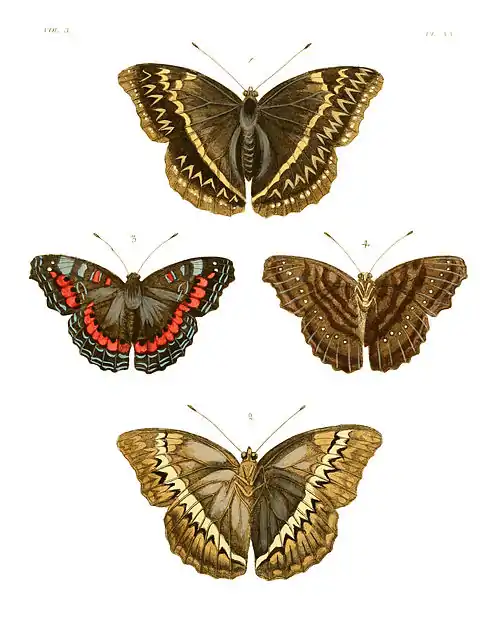
NYMPHALIS ALTHEA.
Plate XX. fig. 1, 2.
Genus. Nymphalis, Latr. God. Papilio (Nymphalis), Fabr.
Nymphalis Althea. Alis dentatis suprà fuscis, fasciâ strigâque angulato-dentatis albis; subtùs flavescentibus lituris atris fasciâ strigisque iisdem. (Expans. Alar. 3 unc. 3 lin.)
Syn. Papilio (N.) Althea, Fabr. Spec. Ins. 2. p. 88. No. 389. Ent. Syst. III. 1. p. 113. No. 347. Cramer, pl. 89. fig. E. F.
Nymphalis A., Enc. Méth. ix. p. 383. No. 111.
Habitat: "Sierra Leone, Mr. Smeathman, 1775" (Drury's MSS.).
VANESSA AMESTRIS.
Plate XX. fig. 3, 4.
Genus. Vanessa, Fabr. Latr. God. Hamadryades, Hübn. Papilio (Nymph. Phal.), Drury.
Vanessa Amestris. Alis dentatis, anticis falcatis posticis rotundatis; omnibus suprà fuscis ad extimum fasciis tribus macularibus transversis, intermediâ ferrugineâ, (ad apicem maculis duabus albis) cæteris cœrulescentibus subtus marmoratis. (Expans. Alar. 2 unc. 6 lin.)
Syn. Papilio (N. P.) Amestris, Drury, App. vol. 3.
Papilio (N.) Amestris, Fabr. Ent. Syst. III. 1. p. 116. 360.
Papilio (N.) Zingha, Fabr. loc. cit. No. 358.
Vanessa Erinna, Enc. Méth. ix. p. 315.
Habitat: "Sierra Leone, Mr. Smeathman, 1775" (Drury's MSS.). "In Indiis, Dom Drury" (Fabr. sub P. N. Amestris, incorrectly).
PLATE XXI.
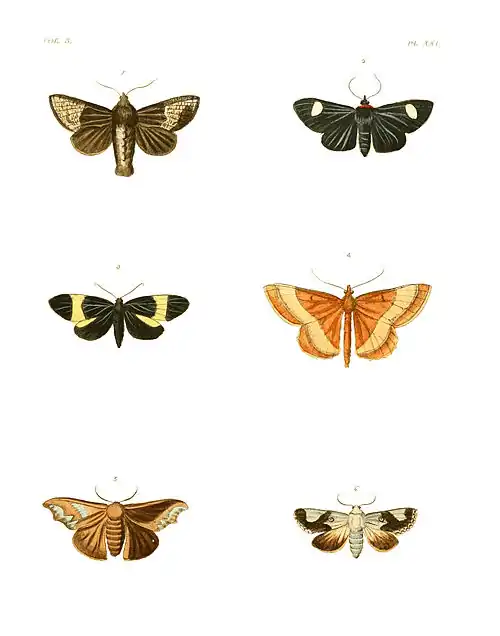
NOCTUA TRISTIS.
Plate XXI. fig. 1.
Genus. Noctua, Auct. Subgenus ——?
Noctua Tristis. Alis fuscis nigro-atomosis, dimidio basali saturatiori strigàque ad angulum internum anticarum nigrâ. (Expans. Alar. 1 unc. 10 lin.)
Syn. Phalæna (Noctua) Tristis, Drury, App. vol. 3.
Habitat: "Cape of Good Hope" (Drury, in text). "Jamaica" (Drury's MSS.).
GNOPHRIA? COLLARIS.
Plate XXI. fig. 2.
Genus. Gnophria? Steph. Lithosia p., Fabr. Phalæna (Noctua), Drury.
Gnophria? Collaris. Alis nigris, anticarum maculâ pone medium albâ, collari sanguineo. (Expans. Alar. 1 unc. 9 lin.)
Syn. Phalæna (Noctua) Collaris, Drury, App. vol. 3.
Habitat: Brazil. "Rio Janeiro, Mr. Bonifas, 1775" (Drury's MSS.).
CALLIMORPHA CÆNEA.
Plate XXI. fig. 3.
Genus. Callimorpha, Latr. Phalæna (Noctua), Drury.
Callimorpha Cænea. Alis nigris, anticis fasciâ latâ transversâ, margineque antico posticarum flavescentibus. (Expans. Alar. 2 unc. 9 lin.)
Syn. Phalæna Noctua Cænea, Drury, App. vol. 3.
Habitat: Drury (incorrectly?) states that he received this insect both from Madras and Brazil. "Rio Janeiro, Mr. Bonifas, 1775" (Drury's MSS.).
GEOMETRA (PÆCILOPHASIA) FULVATA.
Plate XXI. fig. 4.
Genus. Geometra, Steph. (Subgenus: Pæcilophasia? Steph.)
Geometra (Pæcilophasia) Fulvata. Alis fulvescentibus fasciâ latâ communi dilutiori, anticarum puncto subdiscoidali. (Expans. Alar. 1 unc. 7 lin.)
Syn. Phalæna (Geometra) fulvata, Drury, App. vol. 3.
Habitat: Africa. "Sierra Leone, Mr. Smeathman, 1775" (Drury's MSS.).
NOCTUA (CALYPTRA) LUGUBRIS.
Plate XXI. fig. 5.
Genus. Noctua, Auct. Subgenus: Calyptra, Ochs. Gonoptera, Latr.
Noctua (Calyptra) Lugubris. Alis anticis dentatis subfalcatis, brunneo-fuscis basi saturatioribus, maculis dentatis submarginalibus. (Expans. Alar. 1 unc. 7½ lin.)
Syn. Phalæna (Noctua) lugubris, Drury, App. vol. 3.
Habitat: Madras.
NOCTUA (ACONTIA) MARGARITATA.
Plate XXI. fig. 6.
Genus. Noctua, Auct. Subgenus: Acontia, Ochs. Steph. Curtis. Phalæna (Noctua), Drury.
Noctua (Acontia) Margaritata. Argenteo-alba, alis anticis pone punctum ordinarium fuscis, maculâ magnâ albâ costali margineque postico albo, lunulis punctisque nigricantibus, posticarum margine fusco. (Expans. Alar. 1 unc. 5 lin.)
Syn. Phalæna Noctua Margaritata, Drury, App. vol. 3.
Habitat: New York.
PLATE XXII.
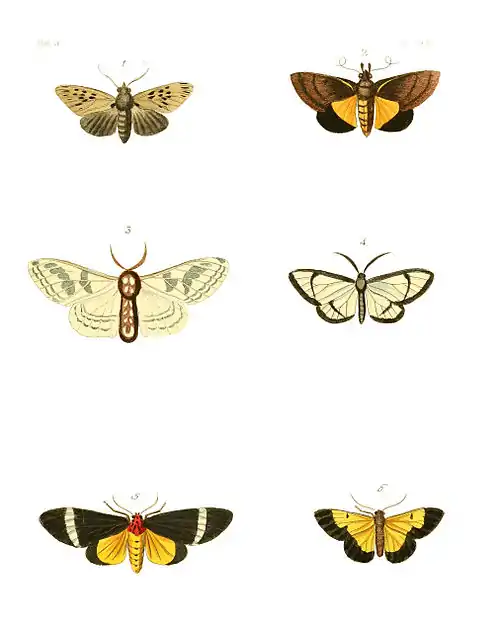
NOCTUA GUTTATA.
Plate XXII. fig. 1.
Genus. Noctua, Auct. (Subgenus: ——?)
Noctua Guttata. alis griseis punctis nonnullis discoidalibus strigisque apicalibus obscurioribus. (Expans. Alar. 1 unc. 7½ lin.)
Syn. Phalæna (Noctua) Guttata, Drury, App. vol. 3.
Habitat: "Brazil" (Drury, in text). "Cape of Good Hope, Mr. Foster, 1775" (Drury's MSS.).
NOCTUA? HESIONE.
Plate XXII. fig. 2.
Genus. Noctua? Auct. (Subgenus: ——?)
Noctua? Hesione. Alis anticis brunneis strigâ longitudinali subcostali luteâ, fasciâque transversali dilutâ, strigis undulatis nigris marginatis, angulis posticis productis; posticis fulvis margine latè nigro. (Expans. Alar. 2 unc.)
Syn. Phalæna (Noctua) Hesione, Drury, App. vol. 3.
Habitat: Brazil, "Rio Janeiro, Mr. Bonifas, 1775" (Drury's MSS.).This insect is evidently the type of a distinct genus from any hitherto described, especially distinguished by the lively colours of the wings, the produced posterior angle of the anterior pair, and the form of the palpi.
ENDROMIS RHODOPE.
Plate XXII. fig. 3.
Genus. Endromis, Ochs. Germar. Dimorpha, Hübn. Phalæna (Bombyx), (Drury.)
Endromis Rhodope. Alis albis pellucidis; strigis duabus undulatis parallelis submarginalibus, maculisque nonnullis discoidalibus anticarum virescentibus. (Expans. Alar. 2 unc. 6 lin.)
Syn. Phalæna (Bombyx) Rhodope, Drury, App. vol. 3.
Habitat: Brazil, "Rio Janeiro, Mr. Bonifas, 1776" (Drury's MSS.).
CALLIMORPHA? DIAPHANA.
Plate XXII. fig. 4.
Genus. Callimorpha? Latr. Phalæna (Noctua), Drury.
Callimorpha? Diaphana. Alis diaphanis, marginibus anticis et externis strigâque transversâ e margine antico ad angulum posticum ductâ, nigris. (Expans. Alar. 1 unc. 9 lin.)
Syn. Phalæna (Noctua) Diaphana, Drury, App. vol. 3.
Habitat: Brazil, "Rio Janeiro, Mr. Bonifas, 1774" (Drury's MSS.).
CALLIMORPHA? PHILETA.
Plate XXII. fig. 5.
Genus. Callimorpha? Latr. Phalæna (Noctua), Drury.
Callimorpha? Phileta. Alis anticis oblongis fuscis, fasciâ transversâ pone medium albâ, posticis fulvis margine externo nigro, thorace sanguineo. (Expans. Alar. 2 unc. 3 lin.)
Syn. Phalæna (Noctua) Phileta, Drury, App. vol. 3.
Habitat: "Sierra Leone, Mr. Smeathman, 1776" (Drury's MSS.).
CALLIMORPHA? EUCHARIS.
Plate XXII. fig. 6.
Genus. Callimorpha? Latr. Phalæna (Noctua), Drury.
Callimorpha? Eucharis. Alis sulphureis, margine postico lato punctoque medio anticarum fuscis. (Expans. Alar. 1 unc. 6 lin.)
Syn. Phalæna (Noctua) Eucharis, Drury, App. vol. 3.
Habitat: Brazil.
PLATE XXIII.
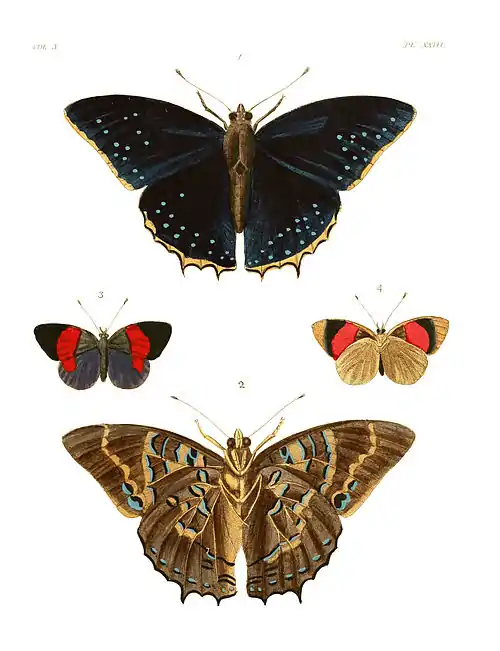
NYMPHALIS (CHARAXES) TIRIDATES.
Plate XXIII. fig. 1, 2.
Genus. Nymphalis, Latr. Papilio (Eq. achiv.) Linn. Drury. Papilio Nymphalis, Fabr. (Subgenus: Charaxes, Boisduval.)
Nymphalis (Charaxes) Tiridates. Alis supra atro-cœruleis, margine postico lunulis ochraceis, omnium dimidio apicali punctis cœrulescentibus. (Expans. Alar. 4 unc. 3 lin.)
Syn. Papilio (N.) Tiridates, Fabr. Spec. Ins. 2. p. 11. No. 43. Cramer, pl. 162. f. A. B. Herbst. Pap. tab. 62. f. 3. 4. Donovan Ins. India, 3. pl. 2. f. 3.
Nymphalis T., Enc. Méth. ix. p. 354. 14.
Habitat: Amboyna, Java (Fabr. & Enc. Méth.). Brazil (Drury, in text). "Rio Janeiro, Mr. Bonifas, 1766" (Drury's MSS.).
NYMPHALIS PYRAMUS ♂.
Plate XXIII. fig. 3, 4.
Genus. Nymphalis, Latr. Papilio (Pleb. rur.), Drury.
Nymphalis Pyramus. Alis nigris (in mare supra violaceo-micantibus) anticis utrinque fasciâ latâ miniatâ: posticis subtus irroratis strigâque marginali cœrulescenti. (Expans. Alar. 1 unc. 7½ lin.)
Syn. Papilio Pyramus, Fabr. Sp. Ins. 2. 130. 590. Ent. Syst. III. 1. p. 323. 223.
Papilio (Pleb. rur.) Pyramus, Drury, App. vol. 3. Stoll Suppl. Cramer, pl. 32. f. 3. 3e. Enc. Méth. ix. p. 422. (Nymphalis P.) Donovan Nat. Repos. 1. t. 3. f. 2. 2.
Habitat: Brazil, "Rio Janeiro, Mr. Bonifas, 1774" (Drury's MSS.).The original Fabrician description of this insect is stated to have been derived from an insect from Cayenne in the collection of Mr. Yeats; and in the Fabrician detailed description, we find the wings characterized thus—"macula magna, in medio, fulva, anticæ subtus concolores." It appears, however, from the observations of Donovan that the celebrated iconographer Jones had made a drawing of Yeats's specimen, from which drawing Donovan published his illustration of the species in the Naturalist's Repository, with the following observations:—"There was a variety of this insect pretty nearly, but not exactly, according with this in the collection of an old and well-known entomologist, a figure of which appeared shortly after the publication of the Fabrician writings as the true Papilio Pyramus. It was not precisely the same as it appeared to us from an inspection of the specimen in the Cabinet of Mr. Drury." Making due allowance for Donovan's over-charged colouring, there is still considerable difference between the figures of Drury and Donovan; in the former the fore-wings being almost entirely red on the under side, whilst in the latter, the upper side of same wings is red, except at the tips. In both these particulars, as will at once be seen from the above quotation of Fabricius, Drury's figure perfectly agrees with the character given of Yeats's specimen; whilst Donovan's differs in each respect. The female of this species is destitute of the purple gloss on the upper surface of the wings, and the red band does not run into the posterior pair.
PLATE XXIV.
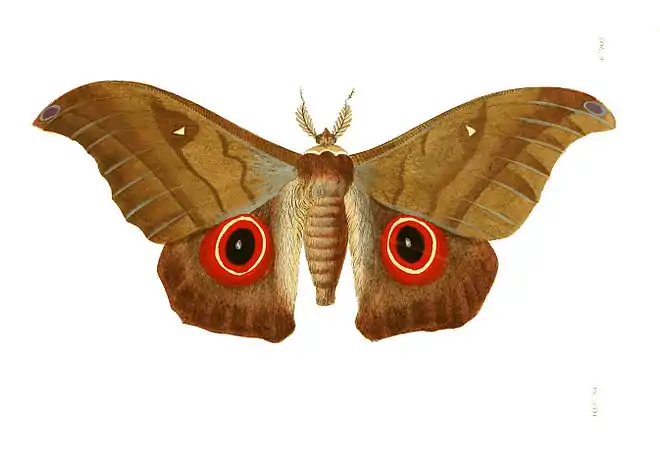
SATURNIA PHÆDUSA.
Genus. Saturnia, Schrank. Attacus, Germ. Phalæna (Attacus), Drury.
Saturnia Phædusa. Alis griseo-fuscis, anticis strigis tribus transversis saturatioribus maculâque-parvà triangulari fenestratâ mediâ; posticis obscurioribus ocello magno nigro, margine carneo-rufo cincto. (Expans. Alar. 7 unc. 9 lin.)
Syn. Phalæna (Attacus) Phædusa, Drury, App. vol. 3.
Bombyx Saturnus, Fabr. Ent. Syst. III. 1. p. 409. Oliv. Enc. Méth. 5. 27. 11.
Habitat: Sierra Leone (Drury). "In Indiis" (Fabricius).
PLATE XXV.
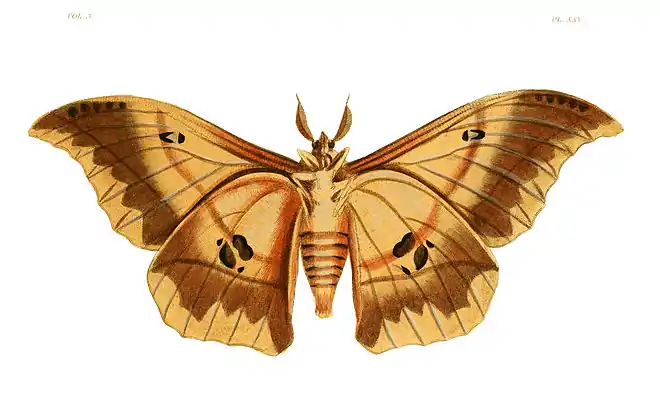
In Mr. Drury's manuscripts I find the insect referred to these two figures is stated to have been obtained from the Duchess of Portland's Museum, and to be an inhabitant of New York.
PLATE XXVI.
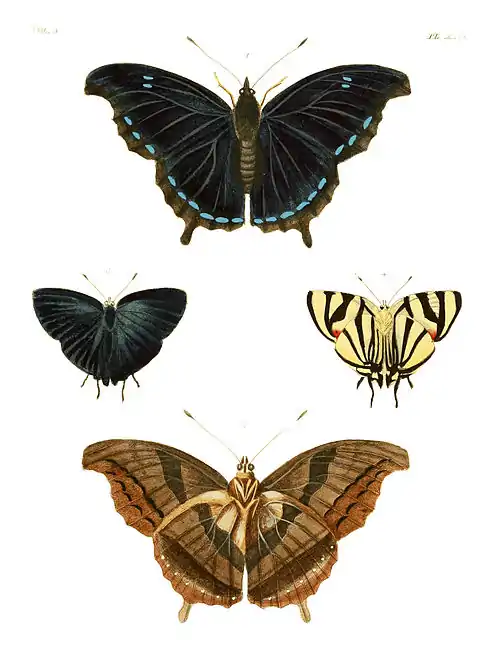
NYMPHALIS LAODICE.
Plate XXVI. fig. 1, 2.
Genus. Nymphalis, Latr. Papilio (Pleb. rur.) Drury.
Nymphalis Laodice. Alis supra atro-cœruleis, limbo postico serie lunularum cœrulescentium; subtus fascià mediâ communi saturatiori, posticis punctis marginalibus albis. (Expans. Alar. 3 unc. 9 lin.)
Syn. Papilio (Nymph. Phal.) Laodice, Drury, App. vol. 3. (1783.)
Papilio Lycurgus, Fabr. Ent. Syst. III. 1. p. 67. No. 209. Enc. Méth. ix. p. 364. No. 49.
Nymphalis Lyc., Paul. Beauv. Ins. d'Afr. et d'Amer. Lep. pl. 4. f. 2.
Habitat: Sierra Leone.
THECLA PHALEROS ♂.
Plate XXVI. fig. 3, 4.
Genus. Thecla, Fabr. (Syst. Gloss.) Polyommatus, Latr. God. Hesperia p. Fabr. (olim.) Papilio (Pleb. rur.), Drury.
Thecla Phaleros. Alis ♂ violaceo-cœruleis nitidis, ♀ albidis apice fusco, subtus albis fasciis transversis margineque nigris ad angulum ani conjunctis. (Expans. Alar. 1 unc. 9 lin.)
Syn. Papilio (Pleb. urb.) Phaleros, Linn. Syst. Nat. 2. p. 796. No. 272. Enc. Méth. ix. p. 628. (Polyomm. Ph.)
Hesperia R. Chiton, Fabr. Ent. Syst. III. 1. p. 262. Donovan Ins. India, 1. pl. 3. f. 1.
Papilio Silenus, Cram. pl. 282. E.
Papilio Agis, Drury, App. vol. 3.
Habitat: Brazil (Drury, in text). "Rio Janeiro, Mr. Bonifas, 1775" (Drury's MSS.). Surinam (Enc. Méth.). India (Linn. Fabr. Donov.).
PLATE XXVII.
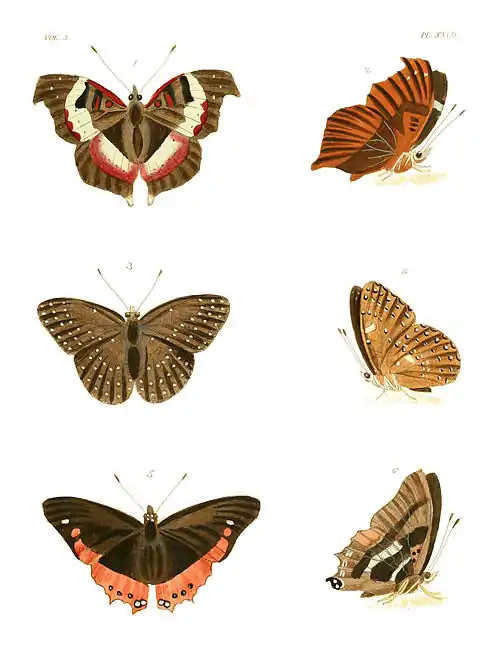
VANESSA PELARGA.
Plate XXVII. fig. 1, 2.
Genus. Vanessa, Fabr. Latr. God. Hamadryades, Hübn. Papilio (Nymph. Phal.) Drury.
Vanessa Pelarga. Alis anticis falcatis, posticis intùs subcaudatis, omnibus suprà fuscis, fasciâ cœrulescenti-albâ, nigro-punctatâ, extrorsumque fulvo inductâ; subtùs xerampelinis lineâ fuscâ communi mediâ. (Expans. Alar. 2 unc. 6 lin.)
Syn. Papilio (N.) Pelarga, Fabr. Syst. Ent. p. 513. No. 296. Drury, App. vol. 3. Stoll Suppl. Cram. pl. 27. f. 2.
Vanessa P., Enc. Méth. ix. p. 313. No. 37.
Habitat: "Sierra Leone, Mr. Smeathman, 1776" (Drury's MSS.).
NYMPHALIS MELEAGRIS.
Plate XXVII. fig. 3, 4.
Genus. Nymphalis, Latr. Papilio (Pleb. rur.), Drury.
Nymphalis Meleagris. Alis suprà olivaceo-fuscis, subtùs lutescentibus; utrinque albo, in triplici serie, multipunctatis. (Expans. Alar. 2 unc. 4½ lin.)
Syn. Papilio Meleagris, Cramer, pl. 66. f. A. B. Herbst. t. 145. f. 1. 2. Drury, App. vol. 3. Fabr. Ent. Syst. III. 1. p. 128. Enc. Méth. ix. p. 387. (Nymphalis M.)
Habitat: "Sierra Leone" (Drury, in text). "Brazil, Mr. Skeene, 1772" (Drury's MSS.).
NYMPHALIS (CHARAXES) ANTICLEA.
Plate XXVII. fig. 5, 6.
Genus. Nymphalis, Latr. Papilio (Eq. achiv.), Linn. Drury. Papilio Nymphalis, Fabr. (Subgenus: Charaxes, Boisduval.)
Nymphalis (Charaxes) Anticlea. Alis suprà fuscis fasciâ terminali fulvâ, in anticis maculari et abbreviatâ, in posticis ocellis 4, anali sesquialtero. (Expans. Alar. 2 unc. 9 lin.)
Syn. Papilio (Nymph. Phal.) Anticlea, Drury, App. vol. 3.
Nymphalis Ant., Enc. Méth. ix. p. 353. No. 9.
Habitat: Sierra Leone (Drury, in text). "Rio Janeiro, Mr. Bonifas, 1766" (Drury's MSS.).
PLATE XXVIII.
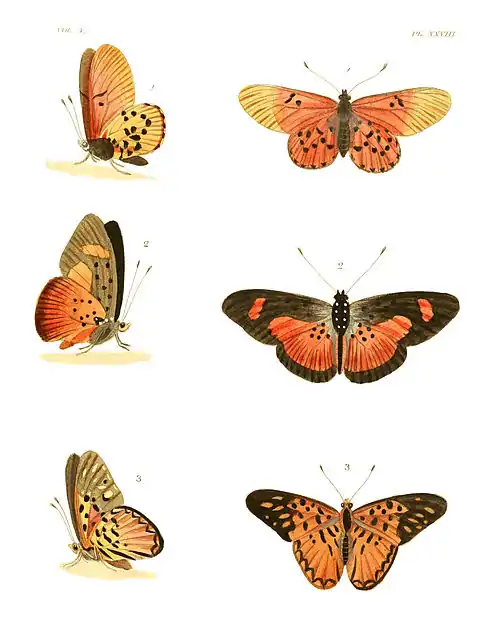
ACRÆA HORTA.
Plate XXVIII. fig. 1, 2.
Genus. Acræa, Fabr. Latr. Papilio (Heliconii), Fabr. olim.
Acræa Horta. Alis oblongis integerrimis, supra fulvis; anticis ad extimum hyalino-cinerascentibus, posticis utrinque nigro punctatis subtusque albidis. (Expans. Alar. 2 unc. 7½ lin.)
Syn. Papilio (Helic.) Horta, Linn. Syst. Nat. 2. p. 755. No. 54. Drury, App. vol. 3. Cramer, Pap. pl. 298. fig. F. G. Herbst. Pap. tab. 83. f. 1. 2. Enc. Méth. ix. p. 231. 1.
Habitat: "Sierra Leone, Mr. Smeathman, 1776" (Drury's MSS.). Cape of Good Hope, and other parts of Africa (Enc. Méth.).
ACRÆA GEA ♂.
Plate XXVIII. fig. 3, 4.
Genus. Acræa, Fabr. Latr. God. Papilio (Heliconii), Fabr. Olim.
Acræa Gea. Alis oblongis integerrimis, anticis utrinque fuscis, fasciis duabus fulvis aut albidis, unâ versus apicem, alterâ connexâ disco posticarum, his subtùs rufescentibus, basi nigro-punctatis, postea striatis. (Expans. Alar. 3 unc.)
Syn. Papilio (Hel.) Gea, Fabr. Spec. Ins. 2. p. 32. No. 136. ♂. Enc. Méth. ix. p. 238. (Acræa G.)
Papilio (H.) Jodutta, Fabr. Ent. Syst. III. 1. p. 175. No. 554. ♀.
Papilio (Hel.) Hirce, Drury, App. vol. 3.
Papilio Epæa, Cramer, pl. 230. f. B.C.
Habitat: Sierra Leone (Drury). "Calabar, in Africa, Capt. Parker, 1771" (Drury's MSS.).
NYMPHALIS HOSTILIA.
Plate XXVIII. fig. 5, 6.
Genus. Nymphalis, Latr. Papilio (Eq. achiv.), Linn. Drury. Papilio Nymphalis, Fabr.
Nymphalis Hostilia. Alis dentatis subconcoloribus, fulvis, basi nigro-maculatis; anticarum apice fusco punctis flavescentibus. (Expans. Alar. 2 unc. 6 lin.)
Syn. Papilio (Dan. Fest.) Hostilia, Drury, App. vol. 3. Fabr. Ent. Syst. III. 1. p. 130. No. 399.
Nymphalis H., Latr. God. Enc. Méth. ix. p. 393.
Habitat: "Sierra Leone, Mr. Smeathman, 1775" (Drury's MSS.).
PLATE XXIX.
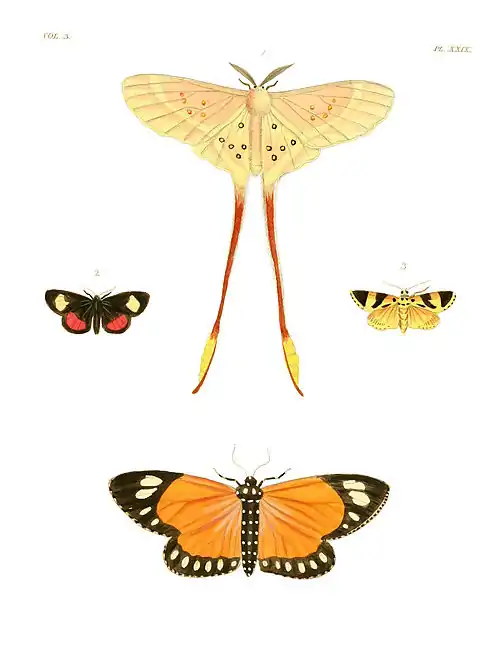
SATURNIA ARGUS.
Plate XXIX. fig. 1.
Genus. Saturnia, Schrank. Attacus, Germ. Phalæna (Attacus), Drury.
Saturnia Argus. Alis pallidè testaceo-albidis punctis ocellaribus fenestratis numerosis, caudis longissimis. (Expans. Alar. 3 unc. 5 lin.)
Syn. Bombyx Argus, Fabr. Ent. Syst. III. 1. p. 414. No. 24. Donovan Nat. Repos. 5. 173. Oliv. Enc. Méth. 5. 29. 22.
Phalæna (Bombyx) brachyura, Cramer Ins. tab. 29. f. 1. Drury, App. vol. 3.
Habitat: "Sierra Leone, Mr. Smeathman, 1775" (Drury's MSS.).I have adopted the Fabrician specific name, notwithstanding its subsequent date, that proposed by Cramer being exceedingly inapplicable. Drury states, on the authority of Mr. Smeathman, that this curious insect was found on the island of Banana. Its flight is exceedingly slow, and its tails seem rather to impede it. Mr. Donovan states that several specimens of this insect had been received from Sierra Leone (which habitat is given by Drury in the body of his work, but corrected as above in the observations communicated to him by Mr. Smeathman) and that he is not aware of the species having occurred in any other part of Africa, neither had he understood that any other collector since Mr. Smeathman had met with the species. Of the original specimens a pair belonged to Mr. Drury, which came into the hands of Mr. Donovan, who also mentions a fine specimen as existing in the Banksian Cabinet at the Linnæan Society; adding, that some few other specimens passed into different continental Cabinets, all of which, however, were those collected by Mr. Smeathman. The late Mr. Haworth, however, (the sale of whose magnificent collection by public auction lasted for ten days,) possessed four specimens of this rare moth, a pair of which were purchased by W. Swainson, Esq., and the remaining pair by myself.
CALLIMORPHA EPIMENIS.
Plate XXIX. fig. 2.
Genus. Callimorpha, Latr. Phalæna (Noctua), Drury.
Callimorpha Epimenis. Alis nigris, anticis maculá magná pone medium albidâ, posticis basi nigris apice fulvis margine atro. (Expans. Alar. 1 unc. 3 lin.)
Syn. Phalæna (Noctua) Epimenis, Drury, App. vol. 3.
Habitat: "Virginia, Mr. Abbot, 1774" (Drury's MSS.).
LITHOSIA? INO.
Plate XXIX. fig. 3.
Genus. Lithosia? Fabr. Phalæna (Noctua), Drury.
Lithosia? Ino. Alis albidis, anticis punctis duobus humeralibus maculisque duabus magnis nigris (scil. ante et pone medium); thorace nigro punctato. (Expans. Alar. 1 unc. 3 lin.)
Syn. Phalæna (Noctua) Ino, Drury, App. vol. 3.
Habitat: "Madras, Mr. Skeene, 1772" (Drury's MSS.).
CALLIMORPHA? HELCITA.
Plate XXIX. fig. 4.
Genus. Callimorpha? Latr. Phalæna (Noctua), Drury.
Callimorpha? Helcita. Alis testaecis apice nigris, fasciâ maculari albâ. (Expans. Alar. 3 unc. 5 lin.)
Syn. Papilio (Dan. Cand.) Helcita, Linn. Syst. Nat. 2. 763. 94.
Phalæna fascelis, Linn. Mus. Ulr. 390. No. 25.
Phalæna (Noctua) H., Drury, App. vol. 3.
Phalæna macularia, Fabr. Ent. Syst. III. 2. p. 140. No. 40.
Habitat: "Sierra Leone, Mr. Smeathman, 1775" (Drury's MSS.). "In Indiis" (Linn.). India (Fabr. incorrectly).Mr. Smeathman states that this insect is found in the savannahs. It is a sluggish creature, and easily taken. A specimen of this very rare insect was sold in the collection of the late Mr. Stothard, on the 18th May, 1835; and was purchased by Thomas Norris, Esq. M.E.S. at the price of fourteen shillings.
PLATE XXX.
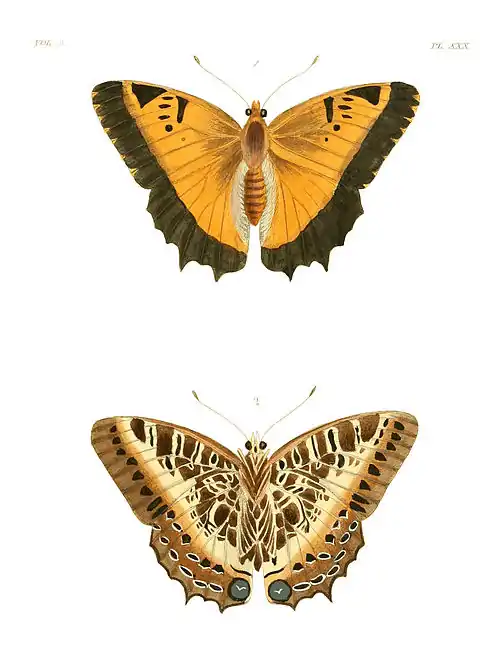
NYMPHALIS (CHARAXES) POLLUX.
Plate XXX. fig. 1, 2.
Genus. Nymphalis, Latr. Papilio (Nymph. Phal.), Drury. (Subgenus: Charaxes, Boisduval.)
Nymphalis (Charaxes) Pollux. Alis supra fulvis, limbo postico latè nigro, subtus ad basin ferrugineis, annulis fasciâque albis. (Expans. Alar. 3 unc. 9 lin.)
Syn. Papilio Pollux, Cram. pl. 37. fig. C. D. Herbst. Pap. t. 63. f. 3. 4.
Papilio (N.) Castor, Fabr. Gen. Ins. Mant. p. 251. Donovan Nat. Repos. 4. 116.
Papilio (Nymph. Ph.) Camulus, Drury, App. vol. 3.
Habitat: "Sierra Leone, Mr. Smeathman, 1776" (Drury's MSS.).We learn, from the observations of Smeathman and Drury, that this is the insect noticed in the observation upon Charaxes Jason, as possessing exceedingly strong powers of flight. Vide Vol. I. Pl. 1. fig. 1.
PLATE XXXI.
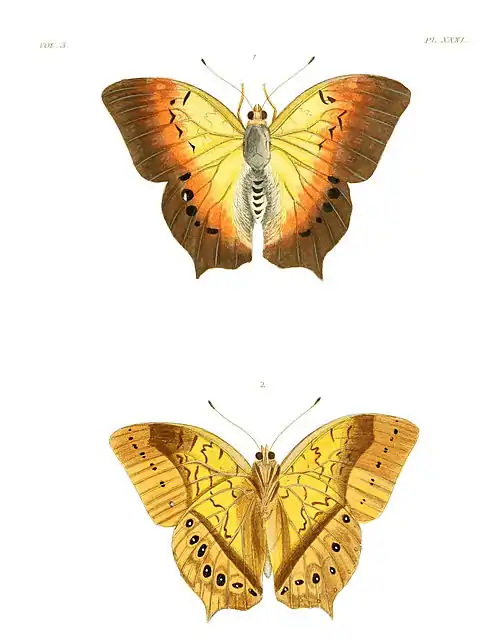
NYMPHALIS VARANES.
Plate XXXI. fig. 1, 2.
Genus. Nymphalis, Latr. Papilio (Nymph. Gemmat.), Drury.
Nymphalis Varanes. Alis supra basi albis immaculatis, apice ferrugineis fulvo et fusco punctatis. (Expans. Alar. 3 unc. 9 lin.)
Syn. Papilio (N.) Varanes, Fabr. Sp. Ins. 2. p. 14. No. 55.
Papilio (Nymph. Gemm.) Varanes, Drury, App. vol. 3.
Papilio V., Cramer, pl. 160. D. E. ♂. pl. 388. A. B. ♀.
Habitat: "Sierra Leone, Mr. Smeathman, 1775" (Drury's MSS.). Caffraria (Enc. Méth.). India (Fabr. incorrectly).This insect, like the last, flies exceedingly swift, and is observed sometimes to settle upon human excrement, a peculiar habit which is also adopted by other species of insects belonging to different orders.
PLATE XXXII.
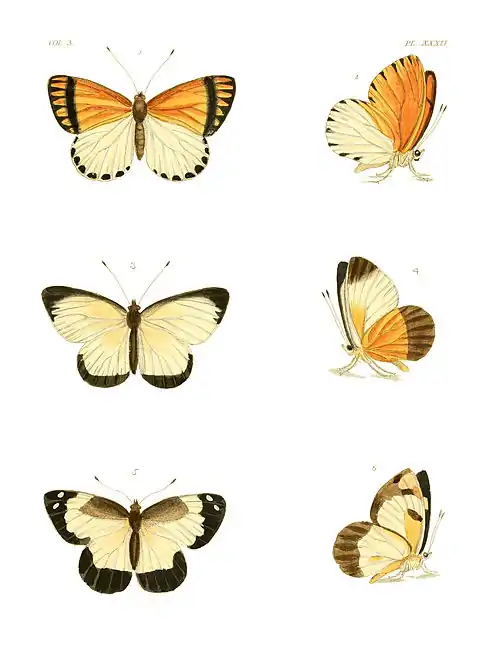
PIERIS EUDOXIA.
Plate XXXII. fig. 1, 2.
Genus. Pieris, Schrank. Papilio (Dan. Cand.), Linn. &c.
Pieris Eudoxia. Alis rotundatis, anticis diluté fulvis posticis albis; omnium limbo communi nigro maculato. (Expans. Alar. 2 unc. 3 lin.)
Syn. Papilio (Dan. Cand.), Cramer, pl. 213. fig. C. Herbst. tab. 107. f. 1. 2. Drury, App. vol. 3. Fabr. Ent. Syst. III. 1. p. 199. 620. Boisduval Hist. Nat. Lepid. 1. 510. No. 105.
Papilio (D. C.) Rhodope, Fabr. Ent. Syst. III. 1. p. 196. No. 609. Donovan Nat. Repos. 3. pl. 86.
Habitat: "Sierra Leone, Mr. Smeathman, 1775" (Drury's MSS.).
PIERIS CHLORIS.
Plate XXXII. fig. 3, 4.
Genus. Pieris, Schrank. Papilio (Dan. Cand.), Linn. &c.
Pieris Chloris. Alis suboblongis, integerrimis, teneris, albis apice nigro, subtùs anticis basi calthaceâ, posticis luteo radiatâ, his limbo latè nigro. (Expans. Alar. 2 unc. 3 lin.)
Syn. Papilio (D. C.) Chloris, Fabr. Syst. Ent. 473. No. 129. Drury, App. vol. 2. Herbst. tab. 99. f. 1. 4. Latr. et God. Enc. Méth. ix. p. 160. Boisduval Hist. Nat. Lepid. 1. 516.
Papilio Thermopylæ, Cramer, pl. 207. fig. F. G.
Habitat: "Sierra Leone, Mr. Smeathman, 1774" (Drury's MSS.).
PIERIS HYPATIA.
Plate XXXII. fig. 5, 6.
Genus. Pieris, Schrank. Papilio (Dan. Cand.), Linn. &c.
Pieris Hypatia. Alis rotundatis integerrimis, suprà nigris, fasciâ albâ communi sinuatâ, subtus anticis maculâ apicali albidâ, posticis basi fulvo radiatis. (Expans. Alar. 2 unc. 3 lin.)
Syn. Pap. (Dan. Cand.) Hypatia, Drury, App. vol. 3.
Papilio Epaphia, Cramer, pl. 207. fig. D. E.
Pieris Higinia, Latr. et God. Enc. Méth. ix. p. 135. No. 45.
Pieris Saba, Fabr. Ent. Syst. III. 1. p. 201. 627. Latr. God. loc. cit. No. 46.
Pieris Malatha, Boisd. Faun. Madagascar, pl. 1. f. 4, 5.
Pieris Orbona, Boisd. loc. cit. pl. 1. f. 3.
Habitat: "Sierra Leone, Mr. Smeathman, 1775" (Drury's MSS.).
PLATE XXXIII.
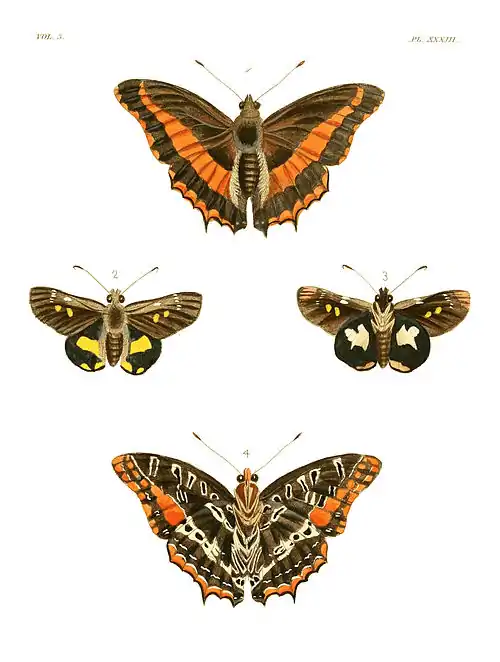
NYMPHALIS (CHARAXES) EUDOXUS.
Plate XXXIII. fig. 1, 4.
Genus. Nymphalis, Latr. Papilio (Nymph. Phal.), Drury. (Subgenus: Charaxes, Boisduval.)
Nymphalis (Charaxes) Eudoxus. Alis supra fasciâ mediâ maculisque marginalibus fulvis, subtùs ad basin ferrugineis annulis argenteis; posticis tantùm fasciâ albâ. (Expans. Alar. 3 unc. 3 lin.)
Syn. Papilio (Equ. Ach.) Eudoxus, Drury, App. vol. 3.
Papilio (N.) Eudoxus, Fabr. Ent. Syst. III. 1. p. 65. No. 203. Enc. Méth. ix. p. 352. No. 6.
Habitat: Sierra Leone.
HESPERIA HELOPS.
Plate XXXIII. fig. 2, 3.
Genus. Hesperia, Fabr. Latr. God. Papilio (Pleb. Urb.), Linn. Drury, &c.
Hesperia Helops. Alis anticis fuscis maculis hyalinis (tribus minutis) subapicalibus; posticis suprà flavis, fasciâ submarginali atrâ arcuatâ, subtùs fuscis disco albo. (Expans. Alar. 2 unc. 2 lin.)
Syn. Papilio (Pleb. Urb.) Helops, Drury, App. vol. 3.
Hesperia (U.) Ennius, Fabr. Ent. Syst. III. 1. p. 337. No. 283. Enc. Méth. ix. 749. No. 54. Donovan Ins. Ind. II. pl. 3. fig. 1.
Habitat: Brazil, "Rio Janeiro, Mr. Bonifas, 1775" (Drury's MSS.). "In Indiis" (Fabr.). India (Donovan).
PLATE XXXIV.
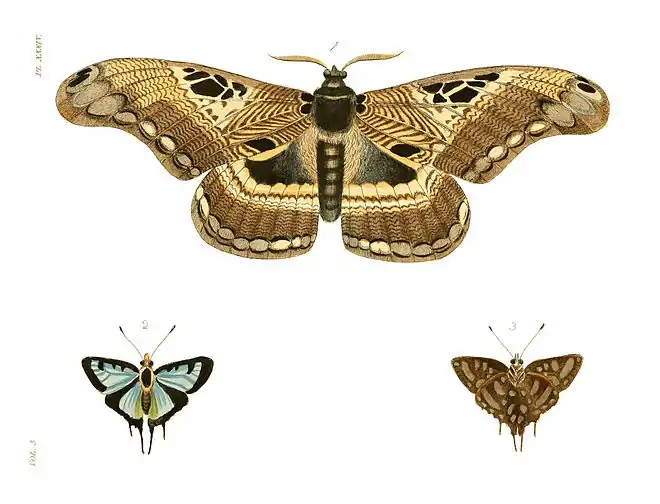
SATURNIA LUCINA.
Plate XXXIV. fig. 1.
Genus. Saturnia, Schrank. Attacus, Germ. Phalæna (Attacus), Drury.
Saturnia Lucina. Alis albido-griseis fusco multi-rivulosis, strigis undulatis submarginalibus, anticis maculis nonnullis mediis ocelloque parvo apicali nigris. (Expans. Alar. 6 unc. 9 lin.)
Syn. Phalæna (Attacus) Lucina, Drury, App. vol. 3. Oliv. Enc. Méth. 5. 31. 27.
Habitat: "Sierra Leone, Mr. Smeathman, 1775" (Drury's MSS.).
THECLA ORCAS.
Plate XXXIV. fig. 2, 3.
Genus. Thecla, Fabr. (Syst. Gloss.) Polyommatus, Latr. God. Hesperia p. Fabr. (olim.) Papilio (Pleb. rur.), Drury.
Thecla Orcas. Alis suprà virescenti-cœruleis, limbo maculisque nonnullis subcostalibus anticarum nigris; subtùs ferrugineo-fuscis maculis numerosis argenteis. (Expans. Alar. 1 unc. 6 lin.)
Syn. Papilio (Pleb. Rur.) Orcas, Drury, App. vol. 3. Enc. Méth. ix. 645. 102. (Polyomm. O.)
Habitat: Sierra Leone.
PLATE XXXV.
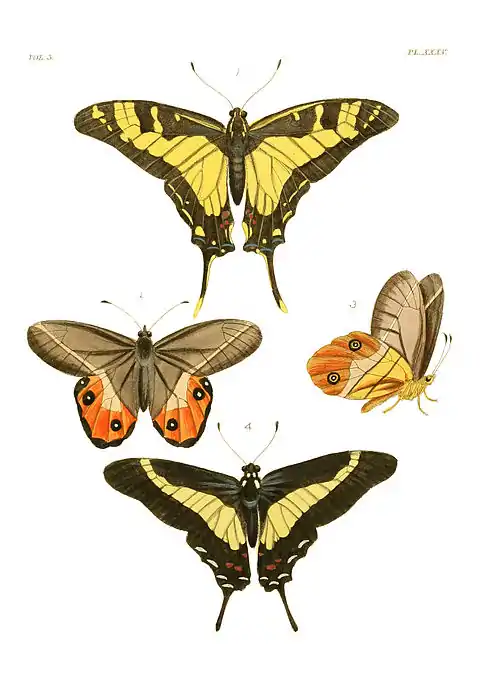
PAPILIO THYASTES.
Plate XXXV. fig. 1.
Genus. Papilio, Auct. Papilio (Eq. Ach.), Drury, Fabr.
Papilio Thyastes. Alis caudatis nigris, fasciâ maculisque flavis, angulo ani sanguineo, posticis subtus lineâ sanguineâ. (Expans. Alar. 4 unc.)
Syn. Papilio (Eq. Ach.) Thyastes, Drury, App. vol. 3. Fabr. Ent. Syst. III. 1. p. 26. No. 77. Enc. Méth. ix. p. 54. Boisduv. Hist. Nat. Lepid. 1. p. 349. 191.
Habitat: Brazil, "Rio Janeiro, Mr. Bonifas, 1776" (Drury's MSS.).
HIPPARCHIA NEREIS ♂.
Plate XXXV. fig. 2, 3.
Genus. Hipparchia, Fabr. Satyrus, Latr. God. Papilio (Helic. Parn.), Drury.
Hipparchia Nereis. Alis fuscis subhyalinis, vittâ communi albâ; posticis ad apicem fulvis, ocellis duobus atris. (Expans. Alar. 3 unc.)
Syn. Papilio (Hel. Parn.) Nereis, Drury, App. vol. 3. Herbst. Pap. tab. 84. f. 1. 2. Stoll Suppl. Cramer, pl. 26. f. 3. Fabr. Ent. Syst. III. 1. 184. Enc. Méth. ix. p. 483. (Satyrus N.)
Habitat: Brazil, "Rio Janeiro, Mr. Bonifas, 1776" (Drury's MSS.).
PAPILIO ASIUS.
Plate XXXV. fig. 4.
Genus. Papilio, Auct. Papilio (Eq. Achiv.), Drury, Fabr.
Papilio Asius. Alis nigris fasciâ communi flavescenti-albâ; posticis caudatis, his subtus basi anguloque ani chermesino maculatis. (Expans. Alar. 3 unc.)
Syn. Papilio (Eq. Troj.) Asius. Fabr. Spec. Ins. 2. p. 5. No. 17. Ent. Syst. III. 1. p. 8. No. 21. Enc. Méth. ix. p. 55. No. 84. Boisduv. Hist. Nat. Lepid. 1. p. 309. 146.
Papilio (Eq. Tr.) Astyagas, Drury, App. vol. 3.
Papilio Manlius, Perty Del. An. Art. Braz. Ins. pl. 29. f. 1.
Habitat: Brazil, "Rio Janeiro, Mr. Bonifas, 1776" (Drury's MSS.).
PLATE XXXVI.
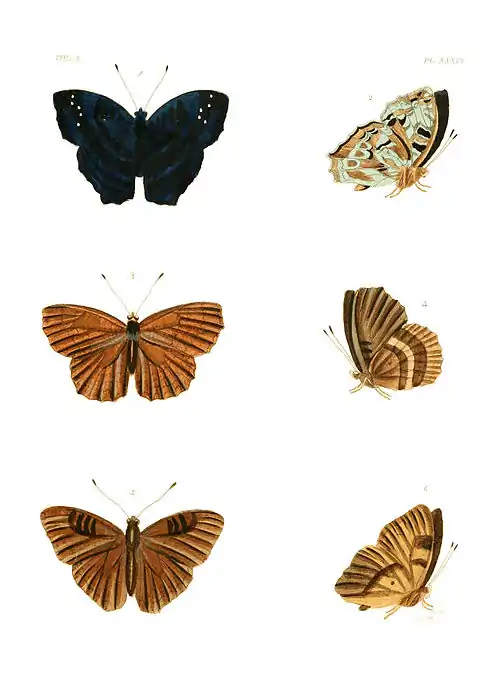
NYMPHALIS AFER.
Plate XXXVI. fig. 1, 2.
Genus. Nymphalis, Latr. Papilio (Nymph. Gemmat.), Drury.
Nymphalis Afer. Alis supra violaceo-cœruleis margine externo nigro, anticis utrinque strigâ apicali punctorum alborum, posticis fusco nebulosis. (Expans. Alar. 2 unc. 1½ lin.)
Syn. Papilio (Nymph. Phal.) Afer, Drury, App. vol. 3. Stoll Suppl. Cramer, pl. 27. fig. 3.
Papilio (N.) Æthiopa, Fabr. Ent. Syst. III. 1. p. 136. No. 420. Enc. Méth. ix. p. 385. No. 119. (Nymph. Æth.)
Habitat: "Sierra Leone, Mr. Smeathman, 1776" (Drury's MSS.).We learn from Mr. Smeathman that this butterfly is found in the gloomy paths of the forests on the continent of Africa.
NYMPHALIS ALPHÆA.
Plate XXXVI. fig. 3, 4.
Genus. Nymphalis, Latr. Papilio (Nymph. Gemmat.) Drury.
Nymphalis Alphæa. Alis lutescentibus strigis undulatis communibus fuscis, puncto dilutiori anticarum subapicali, subtùs brunneis fasciis nigricantibus. (Expans. Alar. 2 unc. 3 lin.)
Syn. Papilio (Nymph.) Alphæa, Drury, App. vol. 3.
Habitat: "Sierra Leone, Mr. Smeathman, 1776" (Drury's MSS.).
NYMPHALIS DORICLÆA.
Plate XXXVI. fig. 5, 6.
Genus. Nymphalis, Latr. Papilio (Nymph. Gemmat.), Drury.
Nymphalis Doriclæa. Alis lutescenti-fuscis suprà strigis duabus punctorum nigrorum, posticis subtus puncto baseos atro. (Expans. Alar. 2 unc. 3 lin.)
Syn. Papilio (Nymph. Phal.) Doriclæa, Drury, App. vol. 3. Fabr. Ent. Syst. III. 1. p. 248. No. 772. Enc. Méth. ix. p. 386. 124.
Habitat: Sierra Leone.
PLATE XXXVII.
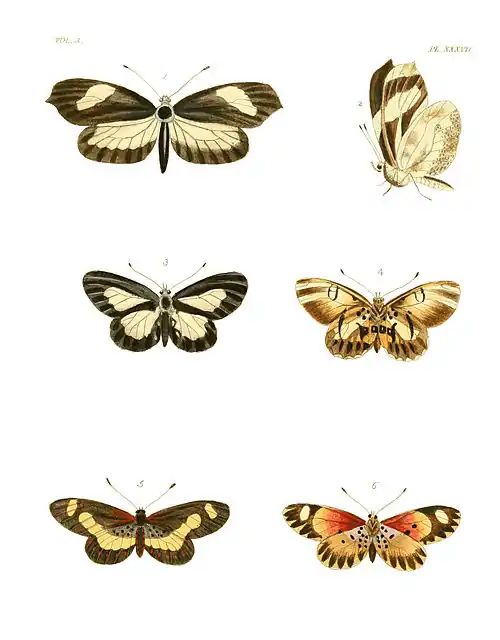
PIERIS (LEPTALIS) CRISIA.
Plate XXXVII. fig. 1, 2.
Genus. Pieris, Schrank. Latr. God. Papilio (Dan. Cand.) Linn. &c. (Subgenus: Leptalis, Boisduval.)
Pieris (Leptalis) Crisia. Alis oblongis, anticis falcato-acuminatis fuscis, fasciâ ante apicem flavescente, posticis integerrimis flavescentibus, limbo fusco. (Expans. Alar. 2 unc. 9 lin.)
Syn. Papilio (Dan. Cand.) Crisia, Drury, App. vol. 3. Fabr. Ent. Syst. III. 1. p. 166. No. 515. Enc. Méth. ix. p. 197. (Pieris Cr.) Boisduval Hist. Nat. Lep. 1. p. 422. (Leptalis Cr.)
Habitat: Brazil. "Rio Janeiro, Mr. Bonifas, 1775" (Drury's MSS.).
ACRÆA ETHOSEA.
Plate XXXVII. fig. 3, 4.
Genus. Acræa, Fabr. Latr. God. Papilio (Heliconii), Fabr. olim.
Acræa Ethosea. Alis oblongis, suprà fuscis disco albo, anticis integerrimis, posticis subdenticulatis, his infrà basi punctis nigris, margine exteriori maculis albis trigonis serie digestis. (Expans. Alar. 2 unc. 3 lin.)
Syn. Papilio (Nymph. Phal.) Ethosea, Drury, App. vol. 3. Enc. Méth. ix. p. 235. No. 17.
Habitat: Sierra Leone.Although Sierra Leone is given by Drury in his published account of this insect as the locality for this species, I find it mentioned in his manuscript Catalogue as being received from "New Zealand, Mr. Banks, 1775." The authors of the Encyclopédie Méthodique evidently knew the species only from Drury's figures and descriptions, and therefore have given the former locality. It is difficult to account for this contradictory statement, or to assert which of these localities is the correct one.
ACRÆA CYNTHIA.
Plate XXXVII. fig. 5, 6.
Genus. Acræa, Fabr. Latr. God. Papilio (Heliconii), Fabr. Olim.
Acræa Cynthia. Alis oblongis integerrimis fuscis, fasciâ communi anticarumque macula apicali, albidis; posticis suprâ punctorum fulvorum serie posticâ. (Expans. Alar. 2 unc. 3 lin.)
Syn. Papilio (Hel.) Cynthius, Drury, App. vol. 3. Herbst. Pap. tab. 80. f. 1. 2.
Acræa Cynthia, Enc. Méth. ix. p. 234.
Habitat: Sierra Leone.In Drury's manuscripts, which have come into my hands, it is stated that this insect was brought from Sierra Leone by Mr. Smeathman, and that "the original insect from which this figure was taken is destroyed, and was of a much livelier colour than those which I judge to be varieties of Cynthius."
PLATE XXXVIII.
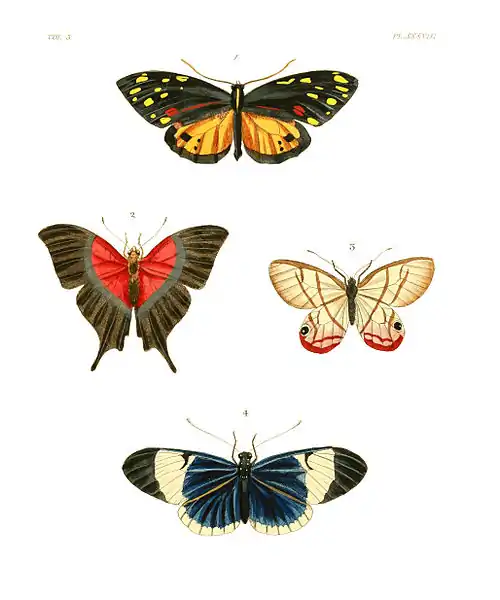
HELICONIA IRENE.
Plate XXXVIII. fig. 1.
Genus. Heliconia, Latr. God. Papilio (Helicon.), Fabr.
Heliconia Irene. Alis oblongis, anticis nigris basi ferrugineo radiatis, à medio ad extimum flavo-maculatis, posticis fulvis limbo exteriori maculisque ante apicem nigris, singulis infrâ punctis marginalibus albis. (Expans. Alar. 3 unc. 3 lin.)
Syn. Papilio (Nymph. Phal.) Irene, Drury, App. vol. 3. Fabr. Ent. Syst. III. 1. p. 165. No. 510. Enc. Méth. ix. p. 223. No. 60.
Habitat: "Jamaica, Mr. Shakespear, 1779" (Drury's MSS.).
NYMPHALIS IOLE.
Plate XXXVIII. fig. 2.
Genus. Nymphalis, Latr. Papilio (Nymph. Gemmat.), Drury.
Nymphalis Iole. Alis suprà basi fulvis, tunc nigris cœruleo-micantibus, subtus nitenti-ferrugineis, strigis duabus nigris undulatis, posticis caudatis. (Expans. Alar. 2 unc. 6 lin.)
Syn. Papilio (Nymph. Phal.) Iole, Drury, App. vol. 3. Stoll Suppl. Cram. pl. 29. fig. 4. 4. D.
Papilio (N) Furcula, Fabr. Ent. Syst. III. 1. p. 79. No. 246. Enc. Méth. ix. p. 360. 36. (Nymphalis F.) Donovan Nat. Repos. 5. 151.
Habitat: "Jamaica" (Drury, in text). "Madras, Mr. Skeene, 1772" (Drury's MSS.).
HIPPARCHIA ANDROMEDA.
Plate XXXVIII. fig. 3.
Genus. Hipparchia, Fabr. Satyrus, Latr. God. Papilio (Helic. Parn.), Drury.
Hipparchia Andromeda. Alis hyalinis, anticis strigis duabus fuscantibus, posticis apice chermesinis ocello utrinque unico. (Expans. Alar. 2 unc. 3 lin.)
Syn. Papilio (P.) Andromeda, Fabr. Syst. Ent. 467. No. 107. Ent. Syst. III. 1. p. 184. No. 569.
Papilio (Hel. Parn.) Menander, Drury, App. vol. 3. Herbst. Pap. t. 84. fig. 6.
Papilio Philis, Cramer, 387. fig. E.
Papilio Pireta, Cramer, pl. 315. fig. A.
Habitat: Jamaica (Drury). Surinam (Enc. Méth.).
HELICONIA SAPPHO.
Plate XXXVIII. fig. 4.
Genus. Heliconia, Latr. God. Papilio (Helicon.), Fabr.
Heliconia Sappho. Alis oblongis, supra atro cœruleis infrà nigris; anticis utrinque fasciâ transversâ bifidâ; posticis margine exteriori albis, his subtùs basi sanguineo radiatis. (Expans. Alar. 3 unc. 3 lin.)
Syn. Papilio (Hel. Parn.) Sapho, Drury, App. vol. 3. Fabr. Ent. Syst. III. 1. p. 165. No. 511. Stoll Suppl. Cramer, pl. 30. 2. & 2. B. Herbst. Pap. tab. 75. f. 7.
Habitat: "Jamaica, Mr. Shakespear, 1779" (Drury's MSS.).
PLATE XXXIX.
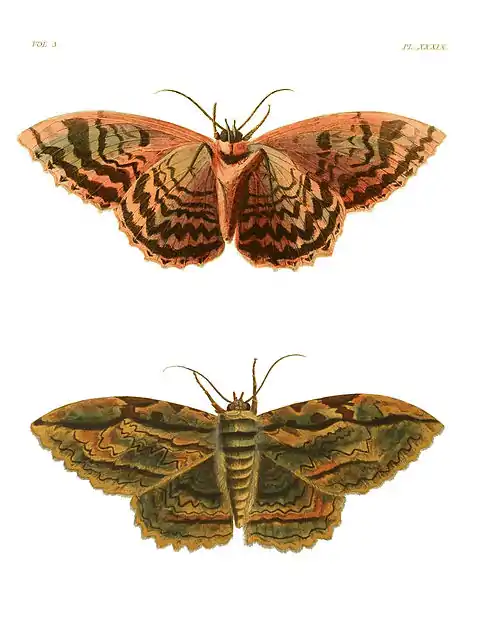
EREBUS ZENOBIA.
Plate XXXIX.
Genus. Erebus, Latr. Thysania, Dalm. Noctua p., Fabr.
Erebus Zenobia. Alis cinereis strigis dentatis et undulatis fuscis et brunneis variegatis, subtùs ferrugineis nigro-undatis. (Expans. Alar. 5 unc. 6 lin.)
Syn. Phalæna (Bombyx) Zenobia, Drury, App. vol. 3. Cramer? tab. 115. A. B.
Noctua Zenobia, Fabr. Ent. Syst. III. 2. p. 8. No. 1. Gmel. Linn. S. N. 2529. 969. Oliv. Enc. Méth. 8. p. 251. 1.
Habitat: "Jamaica, Mr. Kenchan, 1775" (Drury's MSS.).
PLATE XL.
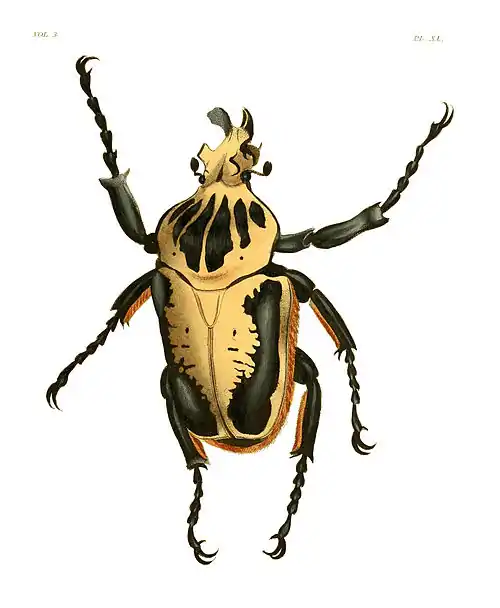
GOLIATHUS DRURII.
Plate XL.
Genus. Goliathus, De Lamarck. Cetonia, Fabr. Scarabæus, Linn. Drury, &c.
Goliathus Drurii. Albidus, thorace lineis sex et disco elytrorum irregulariter nigris, pedibus æneis, capite porrecto bifido. (Long. Corp. 4 unc.)
Syn. Goliathus Maximus var. Drury, App. vol. 3. Fabr. Syst. Eleuth. 2. 135.
Cetonia Goliata, Oliv. Ent. 1. 6. p. 71. t. 9. f. 33. c.
Habitat: Sierra Leone, Africa (Drury).I have ventured, on the authority of several distinguished entomologists, to give this insect as a species distinct from Goliathus maximus, figured in the first volume of these Illustrations, Pl. 31. It is true, indeed, that both are from the tropical districts of the western coast of Africa, and that both exhibit the same general structure and form of the horns, (the variations of which constitute the chief specific differences in these cornuted species). Drury evidently at first regarded it as specifically distinct, for he says, in his observation upon it, "This insect is of the same genus with that described in Vol. 1. Pl. XXXI., but I judge it to be a different species," although in the synoptical appendix to the volume he calls it "a variety of Goliathus," the markings are very different, as may be seen by comparing the two figures; but it might be considered that the specimen represented in the first volume was a rubbed individual of that here figured; this, however, is evidently not the case, because in both descriptions Drury expressly describes the dark part of the elytra as resembling velvet, which could not be the case if the specimen was rubbed. Moreover, a very fine and recent specimen corresponding with the present figure has lately been received by Mr. Havill, of Oxford Street, printseller and naturalist, who has demanded the sum of fifty pounds for it. The individual here figured is in the collection of Mr. MacLeay, to whom I have been indebted for a sight of it, and by whose father it was purchased at the sale of Mr. Drury's collection at the price of £12. 1s. 6d., forming lot 95, in the first day's sale, Thursday May 23, 1805, and described in the catalogue as "Scarabæus Goliathus, var." I have also seen in the Royal Museum at Berlin a female of this genus having the head unarmed, and agreeing in colour and markings with the insect here figured, but which is regarded by Dr. Klug as a species distinct from the Goliath. maximus, and which he has recently described in Ermann's Voyage.
PLATE XLI.
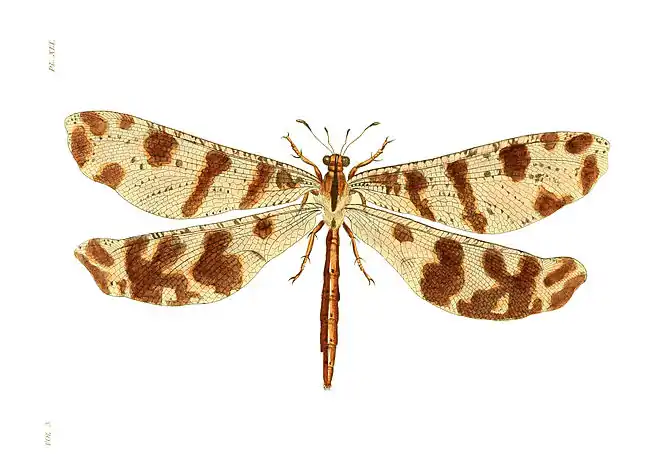
MYRMELEON TORRIDUM.
Plate XLI.
Genus. Myrmeleon, Linn. &c.
Myrmeleon Torridum. Capite thoraceque fulvescentibus, lineâ dorsali nigrâ, hoc griseo-pubescenti, abdomine fusco, alis fusco-punctatis et maculatis, maculis posticarum majoribus et versus apicem crucem irregularem formantibus. (Expans. Alar. 6 unc. 9 lin.)
Syn. Myrmeleon Libelluloides var., Drury, App. vol. 3.
Habitat: Sierra Leone.This is the insect referred to in the observations upon Myrmeleon Libelluloides figured in Vol. 1. tab. 46. fig. 1. as having been regarded by Drury and Fabricius as a variety of that South-Europæan species. That they are specifically distinct both in their habitat and characters will not, I think, be doubted. The peculiar dilatation of the extremity of the posterior wings is a curious character not found in the Libelluloides.
PLATE XLII.
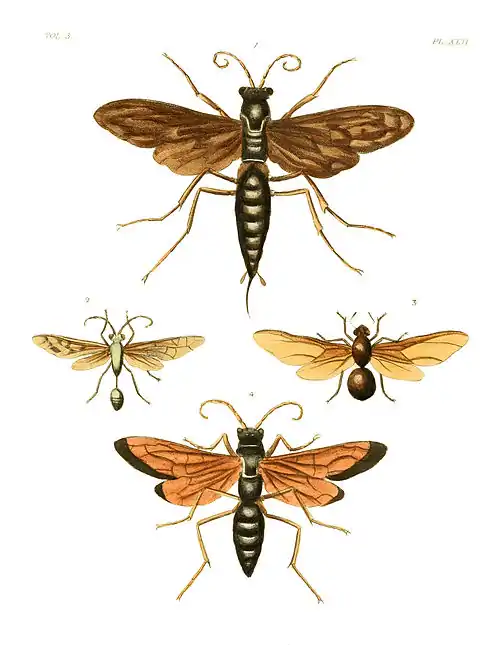
PEPSIS ATROX.
Plate XLII. fig. 1.
Genus. Pepsis, Fabr. Latr. Sphex, Linn. Drury.
Pepsis Atrox. Nigra, alis fusco-diaphanis, pedibus fulvis. (Long. Corp. 2 unc. 3 lin. Expans. Alar. 3 unc. 6 lin.)
Syn. Sphex atrox, Drury, App. vol. 3.
Habitat: Sierra Leone.Fabricius has described an insect from South America, under the name of Pepsis Heros, which nearly agrees with this species, with the following reference—"Sphex Securus, Drury Ins. . tab. . fig. ." It will be sufficient to observe that Drury has described no such insect, although it is probable that Fabricius, who was on terms of intimacy with our author, might have seen the unpublished figure of such insect in his possession. Mr. Smeathman informed our author that he was once stung in the finger by one of these insects, but the pain was not so severe as might have been expected from a wound made by so large a creature belonging to this genus. His method, when stung by any insects in Africa, was to open the puncture with a lancet, and squeeze out the blood and venom together, which, when effectually done, soon caused the pain to abate.
CHLORION FEROX.
Plate XLII. fig. 2.
Genus. Chlorion, Latr. Sphex, Drury.
Chlorion Ferox. Viridi-cyaneum, nitidissimum, antennis pedibusque nigris, alis fuscescentibus. (Expans. Alar. fere 2 unc.)
Syn. Sphex ferus, Drury, App. vol. 3.
Sphex lobata? Fabr. Ent. Syst. 2. 206. 30. Syst. Piez. 217.
Habitat: China.The description given by Drury of this insect entirely agrees with a very common Chinese insect, the Chlorion lobatum, Latr. This figure is however hardly to be recognized.
ATTA FERVENS.
Plate XLII. fig. 3.
Genus. Atta, Fabr. Latreille. Formica, Linn. Drury.
Atta Fervens. Fusca, sericea, alis fuscis, capitis angulis posticis rotundatis. (Expans. Alar. 2 unc. 6 lin.)
Syn. Formica fervens, Drury, App. vol. 2. Say in Journ. of Nat. Hist. Soc. of Boston, p. 290.
Habitat: Musquito Shore, on the Bay of Mexico.This insect (which appears to be a queen or female ant) is nearly allied to a very celebrated South American species, which, from visiting the houses of the inhabitants in great swarms, is termed the visiting ant. (Atta Cephalotes, Fabr.) The late Mr. Say, however, pointed out the differences between the two species in his manuscripts, which have been published in the Journal of the Natural History Society of Boston for 1836.
PEPSIS SEVERA.
Plate XLII. fig. 4.
Genus. Pepsis, Latr. Fabr. Sphex, Linn. Drury.
Pepsis Severa. Atra, alis fulvo-diaphanis apice fuscis, pedibus fulvis femoribus nigris. (Expans. Alar. 3 unc. 3 lin.)
Syn. Sphex Severus, Drury, App. vol. 3.
Habitat: Coast of Africa.
PLATE XLIII.
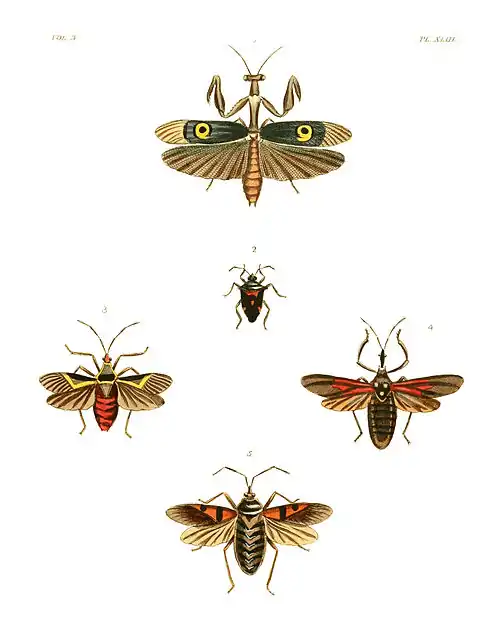
MANTIS (HARPAX) OCELLARIA.
Plate XLIII. fig. 1.
Genus. Mantis, Linn. (Subgenus: Harpax, Serville.)
Mantis (Harpax) Ocellaria. Capite inermi, femoribus posticis lobo apicali, elytris viridibus ocello magno discoidali flavo nigro-cingulato. (Expans. Alar. 2 unc. 6 lin.)
Syn. Mantis ocellaria, Drury, App. vol. 3.
Habitat: Coast of Africa.
"This rare and beautiful mantis was found in a savanna."—Smeathman.
PENTATOMA BICOLORATA.
Plate XLIII. fig. 2.
Genus. Pentatoma, Latreille. Cimex, Fabricius, Drury.
Pentatoma Bicolorata. Fusca, pronoti lateribus in spinam obtusam utrinque productis, scutello versus basin et ad apicem elytrorumque maculâ costali fulvis. (Long. Corp. lin. 7.)
Syn. Cimex rostratus, Drury, App. vol. 2.
La punaise à sept taches, Stoll, pl. 14. fig. 97.
Habitat: Sierra Leone (Drury). Coast of Guinea (Stoll).I have been compelled to propose another specific name for this insect, that given to it by our author being quite inexpressive.
CERBUS? FLAVEOLUS.
Plate XLIII. fig. 3.
Genus. Cerbus? Hahn. Cimex, Drury.
Cerbus? Flaveolus. Fuscus, pronoti marginibus fasciâque angulatâ elytrorum fulvis; abdomine rufo, nigro marginato. (Expans. Alar. 1 unc. 9 lin.)
Syn. Cimex flaveolus, Drury, App. vol. 3.
Habitat: Sierra Leone.
DIASPIDIUS SCAPHA.
Plate XLIII. fig. 4.
Genus. Diaspidius, Westw. Cimex, Drury.
Diaspidius Scapha. Fulvus; capite, antennis, pronoti lobo antico, membranâ elytrorum pedibusque nigris. (Expans. Alar. 2 unc.)
Syn. Cimex Scapha, Drury, App. vol. 3.
Habitat: Sierra Leone.This insect differs so much from the other species of the extensive family Reduviidæ, that I have been compelled to raise it to the rank of a distinct genus, the characters of which are as well marked as those of the majority of the genera recently proposed by the Continental Entomologists in this group. Its characters as a genus are—
PYRRHOCORIS PRINCEPS.
Plate XLIII. fig. 5.
Genus. Pyrrhocoris, Fallen, Burmeister. Astemma, St. Farg. & Serv. Platynotus, Schill.
Pyrrhocoris Princeps. Sanguineus; pronoti lobo antico in medio, elytrorum fasciâ versus basin maculâque costali mediâ nigris, membranâ apicali fuscâ, femoribus in medio nigris. (Expans. Alar. 2 unc.)
Syn. Cimex longirostris, Drury, App. vol. 3.
Habitat: Sierra Leone.The name applied to this species by Drury is so inexpressive that I have been induced to propose for it a new specific designation, which has allusion to its large size and rich colouring.
PLATE XLIV.
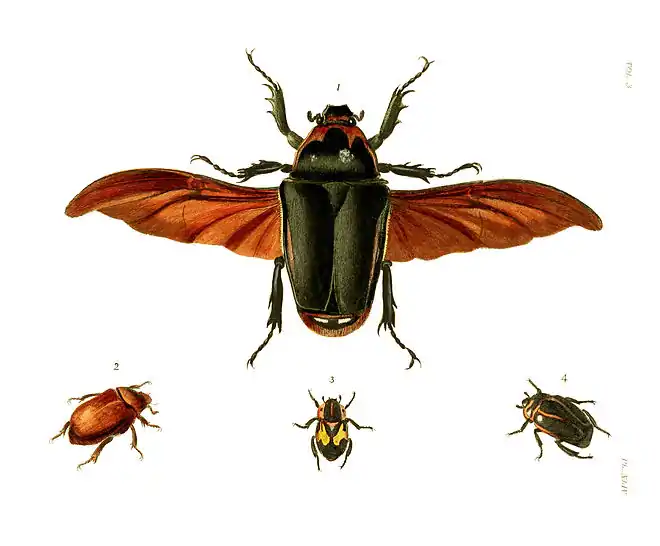
CETONIA TORQUATA.
Plate XLIV. fig. 1.
Genus. Cetonia, Fabricius, &c. Scarabæus, Linn. &c.
Cetonia Torquata. Obscure viridis, thoracis margine antico luteo, pygidii maculis duabus albis; elytrorum apice suturali spinoso. (Long. Corp. 2 unc. 6 lin.)
Syn. Scar. torquatus, Drury, App. vol. 3. Herbst. Col. III. p. 198. t. 28. f. 1. Schon. Syn. Ins. 3. 117.
Habitat: Sierra Leone.This splendid and exceedingly rare insect flew on board a ship at Sierra Leone, and was taken on the awning on the following morning. It seems to be unknown to the French Entomologists, and is omitted in the "Monographie des Cétoines" of Messrs. Gory and Perchéron.
PELIDNOTA UNICOLOR.
Plate XLIV. fig. 2.
Genus. Pelidnota, MacLeay. Scarabæus p., Drury.
Pelidnota Unicolor. Tota lutea; elytris tenuiter striatis. (Long Corp. 1 unc. 1½ lin.)
Syn. Scarabæus unicolor, Drury, App. vol. 3.
Melolontha Druryana, Herbst. Col. II. p. 163. 121. t. 27. f. 3.
Melolontha lutea, Olivier Ent. 1. 5. p. 23. t. 19. 1. f. 2.
Pelidnota testacea, Deg. Cat.
Habitat: Brazil.
RUTELA LINEOLA.
Plate XLIV. fig. 3.
Genus. Rutela, Latreille. Scarabæus p. Drury. Cetonia p. Fabr.
Rutela Lineola. Nigra, lineâ a capite ad scutellum ductâ, lateribusque flavis, elytrorum plagâ magnâ flavidâ. (Long. Corp. 7½ lin.)
Syn. Scarabæus Lineola var. Linn. Syst. Nat. 1. II. p. 552. 53. Fabr. Syst. El. II. p. 145. 53. (Cetonia L.) Syst. Ent. p. 46. 17. Oliv. Ent. 1. 6. p. 78. 98. t. 11. f. 106. var. β.
Cetonia Ephippium, Fabr. Mantiss. 1. p. 29. 31.
Scarabæus Hespera, Drury, App. vol. 2.
Habitat: Brazil.The specimen here figured appears to differ from the ordinary character of the species in having the thorax more strongly marked with dark yellow.
MACRASPIS FUCATA.
Plate XLIV. fig. 4.
Genus. Macraspis, MacLeay. Cetonia p., Fabricius. Scarabæus p., Drury.
Macraspis Fucata. Atra nitida, thoracis margine omni elytrorumque vittis duabus flavis. (Long. Corp. 10½ lin.)
Syn. Cetonia fucata, Fabr. Syst. El. II. p. 151. 82. Ent. Syst. 1. II. p. 145. 69. Sch. Syn. Ins. vol. 3. p. 158.
Cetonia quadri-vittata, Oliv. Ent. 1. 6. p. 73. 92. t. 7. f. 65.
Scarabæus Cinctus, Drury, App. vol. 2. Herbst. Col. III. p. 249. 38. t. 31. f. 5. (Cetonia c.)
Habitat: Rio Janeiro.
PLATE XLV.

ECTRICHODIA BARBICORNIS.
Plate XLV. fig. 1.
Genus. Ectrichodia, Laporte. Ectrichotes, Burmeister. Loricerus, Hahn.
Ectrichodia Barbicornis. Nigra; thorace, abdominis lateribus pedibusque rufis, scutello nigro nitido. (Long. Corp. 1 unc. 1½ lin.)
Syn. Reduvius barbicornis, Fabr. Ent. Syst. 4. 194. 4. Syst. Rh. 267. 4. Drury, App. vol. 3. (Cimex b.)
Habitat: Sierra Leone.
CERBUS FALX.
Plate XLV. fig. 2.
Genus. Cerbus, Hahn. Anisoscelis, Latr. Lygæus, Fabr.
Cerbus Falx. Fuscus, thoracis lateribus compresso-lunatis serratis, femoribus posticis dilatatis haud dentatis, tibiisque posticis membranaceo-dilatatis. (Long. Corp. 9½ lin.)
Syn. Cimex falx, Drury, App. vol. 3.
Habitat: Coast of Africa.This insect is very nearly allied to Lygæus Tragus Wolff, fig. 188, which is, however, an inhabitant of China.
DIACTOR LATIPES.
Plate XLV. fig. 3.
Genus. Diactor, Burmeister. Acanthocephalus, Laporte. Cimex, Drury. Lygæus, Fabr.
Diactor Latipes. Fuscus sive brunneus, unicolor; pronoto cano granoso, elytrorum venis rufis, tarsis posticis pallidis. (Long. Corp. 1 unc. 1½ lin.)
Syn. Cimex latipes, Drury, App. vol. 3.
Lygæus compressipes, Fabr. Syst. Rh. 209. 24. Stoll Cim. t. 2. f. 14. Burmeister Handb. 2. 334. (Diactor c.)
Habitat: Jamaica (Drury). South America.
HAMMATOCERUS PURCIS.
Plate XLV. fig. 4.
Genus. Hammatocerus, Burm. Hammacerus, Laporte. Cimex, Drury.
Hammatocerus Purcis. Niger, undique granosus, elytris basi albis, femorum posticorum basi sanguineâ. (Long. Corp. 1 unc.)
Syn. Cimex Purcis, Drury, App. vol. 3. Brown Ill. tab. 70. f. 2.
Reduvius Nychthemerus, Illig. Burm. vol. 2. 236. 1. (Hammatocerus n.)
Hammacerus conspicillaris var. Laporte Hem. 79.
Habitat: Virginia (Drury). Georgia (Burmeister).
CERBUS SANCTUS.
Plate XLV. fig. 5.
Genus. Cerbus, Hahn. Anisoscelis, Latr. Lygæus, Fabr.
Cerbus Sanctus. Fuscus, thorace maculâque cruciatâ elytrorum fulvis, thorace inermi, pedibus nigris femoribus posticis maximis, tibiis mediocribus. (Long. Corp. fere 1 unc.)
Syn. Cimex Sanctus, Drury, App. vol. 3.
Habitat: Sierra Leone.Fabricius has applied the specific name of Sanctus to one of the species of thick-legged Coreidæ, from Brazil, which is placed by Burmeister in the Genus Crinocerus. Drury quoted the Fabrician description as belonging to his species, but the diversity in their locality would alone be sufficient to prove them to be distinct.
RAPHIGASTER VALIDUS.
Plate XLV. fig. 6.
CERBUS UMBROSUS.
Plate XLV. fig. 7.
Genus. Cerbus, Hahn. Anisoscelis, Latr. Lygæus, Fabr.
Cerbus Umbrosus. Obscurè fulvescens, pronoti disco striis tribus nigris, antennarum articulo ultimo fulvo, elytris striis obliquis nigris notatis, membranâ apicali æneâ nitidâ, femoribus tibiisque posticis serratis. (Long. Corp. 1 unc. 3 lin.)
Syn. Cimex umbrosus, Drury, App. vol. 3.
Habitat: Brazil.
HAMMATOCERUS CONSPICILLARIS.
Plate XLV. fig. 8.
Genus. Hammatocerus, Burm. Hammacerus, Laporte. Cimex, Drury.
Hammatocerus Conspicillaris. Niger, elytris basi albis, maculâ irregulari nigrâ, abdominis marginibus rubro-maculatis. (Long. Corp. 1 unc. 1½ lin.)
Syn. Cimex conspicillaris, Drury, App. vol. 3. Laporte Hemipt. p. 79. Burmeister Hem. p. 236. 2.
Habitat: Brazil.
PLATE XLVI.

PENTATOMA CATENA.
Plate XLVI. fig. 1.
Genus. Pentatoma, Latreille. Cimex, Fabr. Drury.
Pentatoma Catena. Albida, pronoti dorso maculâ magnâ nigrâ, lineâ tenui albâ in medio divisâ, scutello maculâ basali, alterâ subapicali, membranâque elytrorum nigris. (Long. Corp. lin. 7½.)
Syn. Cimex catena, Drury, App. vol. 3.
Habitat: Brazil.
EDESSA VIRENS.
Plate XLVI. fig. 2.
Genus. Edessa, Fabr. Centroproctus, Hahn. Cimex, Drury.
Edessa Virens. Obscure virescens, elytris fuscis margine externo pallido, pronoto lateribus utrinque in spinam longam rectam et acutam productis. (Long. Corp. 10½ lin.)
Syn. Cimex virens, Drury, App. vol. 3.
Edessa cervus? Fabr. Syst. Rh. 146. 2.
Habitat: Brazil.
LARGUS LINEOLA.
Plate XLVI. fig. 3.
Genus. Largus, Hahn. Euryopthalmus, Laporte. Cimex, Drury.
Largus Lineola. Ferrugineo-niger, profunde punctatus, pronoto postice luteo, membranâ albido-cinereâ fusco venosâ limbo fusco. (Long. Corp. 6 lin.)
Syn. Cimex Lineola, Linn. Syst. Nat. p. 721. No. 52.
Cimex punctatus, De Geer Mem. pl. 34. fig. 17. 18.
Cimex humilis, Drury, App. vol. 3. Hahn. Wanzen. Art. Ins. t. 2. f. 6. (Largus h.) Stoll, tab. 27. fig. 265.
Euryopth. puncticollis, Laporte Hemipt. 38. 4.
Lygæus Mutilis. Perty Del. Art. Braz. pl. 34. f. 9.
Habitat: Brazil.
PENTATOMA SPECTABILIS.
Plate XLVI. fig. 4.
Genus. Pentatoma, Latreille. Cimex, Fabr. Drury.
Pentatoma Spectabilis. Capite rufescenti postice nigro, pronoto albido, antice maculisque duabus posticis nigris, scutello et corio albidis fasciâ latâ communi membranâque apicali nigris. (Long. Corp. 7½ lin.)
Syn. Cimex spectabilis, Drury, App. vol. 3.
Habitat: Brazil.
PENTATOMA RUTILANS.
Plate XLVI. fig. 5.
Genus. Pentatoma, Latreille. Cimex, Fabr. Drury.
Pentatoma Rutilans. Cyanea aut viridi ænea, pronoti fasciâ transversâ anticâ, scutelli apice elytrorumque basi internè sanguineis, abdomine sanguineo maculis marginalibus pedibusque nigris. (Long. Corp. 1 unc. 3 lin.)
Syn. Edessa rutilans, Fabr. Syst. Rh. 151. 25.
Cimex anchorago, Drury, App. vol. 3. (nec Fabr. Ent. Syst. 4. 86. 25.)
Habitat: Sierra Leone.
PENTATOMA REGIA.
Plate XLVI. fig. 6.
Genus. Pentatoma, Latreille. Cimex, Fabr. Drury.
Pentatoma Regia. Lutea; capite, pronoti maculis duabus oblongis, scutelli basi, elytrorum maculâ centrali membranâque apicali nigris. (Long. Corp. lin 7½.)
Syn. Cimex regius, Drury, App. vol. 3.
Pentatoma catena var. vel sexus alter? Drury, in text.
Habitat: Brazil.
ASPONGOPUS JANUS.
Plate XLVI. fig. 7.
Genus. Aspongopus, Lap. Burm. Edessa, Fabr. Cimex, Drury.
Aspongopus Janus. Niger, supra ruber; capite, pronoti maculâ anticâ, scutelli basi, membranâque nigris. (Long. Corp. 10 lin.)
Syn. Cimex Janus, Fabr. Ent. Syst. 4. 107. 105. Syst. Rhyng. 151. 23. (Edessa J.) Stoll Cim. 2. t. 6. f. 41. Wolff. Cim. 1. 13. t. 2. f. 13. Burmeister Hemipt. p. 352. 3. (Aspongopus J.)
Cimex Afer, Drury, App. vol. 3.
Habitat: Coast of Coromandel (Drury). "In Americæ insulis" (Fabr. haud recte).The specific name, Afer, given to this insect, although having the priority in point of date over that of Fabricius, is so completely inappropriate that I have not hesitated in adopting the latter.
PENTATOMA PULCHELLA.
Plate XLVI. fig. 8.
Genus. Pentatoma, Latreille. Cimex, Fabr. Drury.
Pentatoma Pulchella. Sanguinea, supra cœruleo nigra, fasciis duabus sanguineis, anticâ arcuatâ, antennis pedibusque nigris. (Long. Corp. 10 lin.)
Syn. Cimex pulchellus, Drury, App. vol. 3. Stoll, pl. 5. fig. 30. & pl. 21. fig. 142.
Cimex concentricus, Klug, Burmeister Hemipt. 365. 5.
Habitat: Bay of Honduras (Drury). Para (Burmeister). Guiana (J. O. W.).
SPHÆROCORIS ANNULUS.
Plate XLVI. fig. 9.
Genus. Sphærocoris, Burmeister. Tetyra, Fabr. Cimex, Drury.
Sphærocoris Argus. Lutea, guttis 15 pallidis sive rubris nigro-cinctis. (Long. Corp. lin. 4.)
Syn. Cimex annulus, Fabr. Ent. Syst. 4. 82. 10. Syst. Rh. 132. 20. (Tetyra A.)
Cimex Argus, Drury, App. vol. 3. (nec Fabr. Syst. Rh. 533.) Stoll Cim. pl. 7. fig. 50.
Sphærocoris Argus, Burmeister Hemipt. 391. No. 2?
Scutellera gibbosa, Pal. Beauv. Ins. d'Afr. et d'Amer. Hemipt. pl. 5. b. f. 3.
Habitat: Sierra Leone.There is some confusion as to the specific names of the insects composing the present genus. The Tetyra Argus of Fabricius, with which the species here figured (from Sierra Leone) was considered identical by Drury, is an inhabitant of South America. Dr. Burmeister has also confused it with a species from the Cape of Good Hope.
PLATE XLVII.
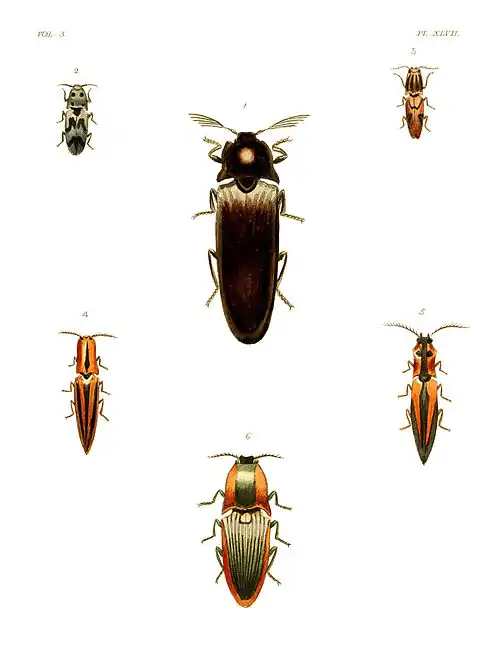
ELATER (TETRALOBUS) FLABELLICORNIS.
Plate XLVII. fig. 1.
Genus. Elater, Linn, &c. (Subgenus: Tetralobus, Encycl. Méth.)
Elater (Tetralobus) Flabellicornis. Fuscus, antennis 8-laminatis, elytris nitidis lævibus. (Long. Corp. 2 unc. 6 lin.)
Syn. Elater flabellicornis, Linn. Syst. Nat. 1. 11. p. 651. 1.? Fabr. Syst. Ent. 1. App. p. 824. 1.? Syst. Eleuth. II. p. 221. 2.? De Jean Catal. Col. 2nd Edit. 85. Oliv. Ent. II. 31. p. 8. t. 3. fig. 28.? Herbst. Col. ix. p. 320. t. 127. f. 1.?
Elater Gigas, Fabr. Syst. Eleuth. II. p. 221. 1.?
Habitat: Sierra Leone (Drury, Afzelius, Schonh.). Guinea (De Jean). India (Linn. Fabr. Oliv.).This figure has been usually cited as the Elater flabellicornis Linn., the habitat of which is said to be India, whereas the real habitat of Drury's insect, as confirmed by Afzelius and De Jean, is Sierra Leone and Guinea. This insect was sometimes found by Mr. Smeathman in the evenings, having flown into the houses, to which it was attracted by the lights.
ELATER (AGRYPNUS) QUADRI-MACULATUS.
Plate XLVII. fig. 2.
Genus. Elater, Linn. &c. (Subgenus: Agrypnus, Eschscholtz.)
Elater (Agrypnus) Quadri-maculatus. Cinereus, thoracis punctis quatuor, elytris fasciis duabus undulatis nigris. (Long. Corp. 9 lin.)
Syn. Elater quadri-maculatus, Fabr. Ent. Syst. 1. II. p. 219. 14. Syst. Eleuth. II. p. 224. 13. Oliv. Ent. II. 31. p. 20. t. 8. f. 79. Herbst. Col. x. p. 105. t. 168. f. 3. Klug Ermann's Voy. App. p. 31. pl. 15. f. 3.
Elater fasciatus, Drury, App. vol. 3.
Habitat: Coast of Africa (Drury). "In Africa æquinoctiali" (Fabr.).
ELATER (CARDIOPHORUS?) PICTUS.
Plate XLVII. fig. 3.
Genus. Elater, Linn. &c. (Subgenus: Cardiophorus, Eschsch.?)
Elater (Cardiophorus?) Pictus. Fulvus, antennis nigris serratis, thorace elytrisque nigro-lineatis et undulatis, his etiam maculâ utrinque triangulari nigrâ. (Long. Corp. 9 lin.)
Syn. Elater pictus, Drury, App. vol. 3. Schonh. Syn. Ins. 3. 277.
Habitat: Coast of Africa.
ELATER (SEMIOTUS) LIGNEUS.
Plate XLVII. fig. 4.
Genus. Elater, Linn. &c. (Subgenus: Semiotus, Eschscholtz.) Pericalus, Enc. Méth.
Elater (Semiotus) Ligneus. Ferrugineus, elytris mucronatis vittis duabus lateralibus suturâque obscurioribus, thorace lineâ mediâ nigrâ. (Long. Corp. 1 unc. 3 lin.)
Syn. Elater ligneus, Linn. Amœn. Acad. vi. p. 395. 24. Syst. Nat. 1. II. p. 652. Fabr. Syst. Eleuth. II. p. 224. No. 20. Oliv. Ent. II. 31. p. 17. t. 2. f. 15. Herbst. Col. ix. p. 339. 14. t. 158. f. 8.
Elater serraticornis, Drury, App. vol. 3.
Elater conicus, Voet Col. Ed. Panz. II. p. 110. 9. t. 42. f. 9.
Habitat: Rio Janeiro.
ELATER (SEMIOTUS) SUTURALIS.
Plate XLVII. fig. 5.
Genus. Elater, Linn. &c. (Subgenus: Semiotus.)
Elater (Semiotus) Suturalis. Thorace utrinque unidentato ferrugineo, lineâ dorsali punctisque duobus; coleoptris testaceis vittis tribus atris. (Long. Corp. 1 unc. 5 lin.)
Syn. Elater Suturalis, Fabr. Ent. Syst. 1. II. p. 224. 35. Syst. Eleuth. II. p. 231. 52. Oliv. Ent. II. 31. p. 18. t. 1. f. 3. a. b. c. Herbst. Col. ix. t. 158. f. 5. 6.
Elater angulatus, Drury Ins. App. vol. 3.
Habitat: Brazil.
ELATER (CHALCOLEPIDIUS) PORCATUS.
Plate XLVII. fig. 6.
Genus. Elater, Linn. &c. (Subgenus: Chalcolepidius, Eschscholtz.)
Elater (Chalcolepidius) Porcatus. Viridi-æneus, elytris sulcatis; sulcis villoso-albis, thoracis marginibus luteis. (Long. Corp. 1 unc. 9 lin.)
Syn. Elater porcatus, Fabr. Syst. Ent. p. 211. 8. Syst. Eleuth. II. p. 225. 26. Oliv. Ent. II. 31. p. 14. 10. t. 7. f. 74. Herbst. Col. ix. p. 323. t. 157. f. 3. Drury, App. vol. 3.
Habitat: Bay of Honduras.
PLATE XLVIII.
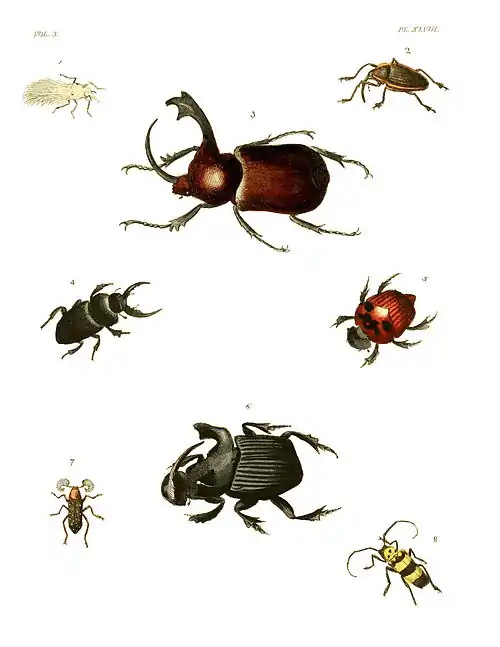
FLATA ——? PUPA?
Plate XLVIII. fig. 1.
Genus. Flata, Fabricius, &c. Aphis, Drury.
Flata —— Pupa? Corpore toto albo pulveroso vel lanoso. (Long. Corp. Ins. haud declar. 9 lin.)
Syn. Aphis lanosa, Drury, App. vol. 3.
Habitat:"I am not certain it is a complete insect."—Drury.
This figure represents an insect belonging to the genus Flata (probably Flata nigricornis from South America) in an imperfect state, being most likely a pupa. The species of this genus are ascertained to be similar to this figure in their preparatory states, and especially the Flata nigricornis which is represented by Stoll, both in the winged and apterous condition, as well as by Donovan, in his Insects of China.
CHOLUS URBANUS.
Plate XLVIII. fig. 2.
Genus. Cholus, Germar. Rhynchænus, Fabr. Curculio p. Linn. &c.
Cholus Urbanus. Fusco-viridis, thorace elytrisque flavo marginatis. (Long. Corp. rostr. inclus. 1 unc. 1½ lin.)
Syn. Curculio urbanus, Oliv. Enc. Méth. v. p. 503. Sch. Syn. Ins. Curcul. 3. 571. 17. (Cholus u.)
Curculio cinctus, Drury, App. vol. 3. (nec Cholus cinctus, Oliv. Rhynchænus.) Herbst. Col. vi. p. 478. t. 79. fig. 7.
Habitat: Musquito Shore, near Honduras.
DYNASTES CLAVIGER.
Plate XLVIII. fig. 3.
Genus. Dynastes, MacLeay. Geotrupes, Fabr. Scarabæus, Linn. Latr.
Dynastes Claviger. Rufus, thoracis cornu elevato apice dilatato; capitis longo, subulato recurvo. (Long. Corp. fere 2 unc.)
Syn. Scarabæus claviger, Linn. Mant. 1. p. 529. Fabr. Syst. Ent. 1. p. 5. No. 7. Syst. El. 1. p. 6. No. 11. Oliv. Ent. 1. 3. p. 20. No. 18. t. 5. fig. 40. a. b. Jabl. Nat. Syst. 1. p. 239. No. 10. t. 3. f. 1. Pal. Beauv. Ins. d'Afr. et d'Amer. Col. ix. pl. 1e. f. 1.
Habitat: Cayenne.
HISTER (OXYSTERNUS) MAXIMUS.
Plate XLVIII. fig. 4.
Genus. Hister, Linn. &c. (Subgenus: Oxysternus, Erichson.)
Hister (Oxysternus) Maximus. Depressus ater nitidus; elytris striatis, mandibulis exsertis capite longioribus. (Long. Corp. cum mandib. 1 unc. 3 lin.)
Syn. Hister maximus, Linn. Syst. Nat. 1. 2. 566. 1.
Hololepta maxillosa, Park Mon. Hist. III. 9. t. ix. f. 7.
Hister maxillosus, Drury, App. vol. 2.
Oxysternus maximus, Erichson in Jahrb. der Ent. 1. 100.
O. maxillosus, Guérin & Percheron Genera des Ins. 1. Col. pl. 7. (♀?) Fabricius Ent. Syst. vol. 4. Append. p. 437. Schonh. Syn. Ins. 1. p. 98.
Habitat: Cayenne.
PHANÆUS FESTIVUS ♀.
Plate XLVIII. fig. 5.
Genus. Phanæus, MacLeay. Copris p. Fabr. Scarabæus p. Linn.
Phanæus Festivus. Thorace gibbo bicorni, capitis cornu erecto ♂, elytris rubro-æneis; ♀ thorace mutico æquali nigro-maculato, capite mutico. (Long. Corp. 1 unc. 1½ lin.)
Syn. Scarabæus festivus, Linn. Syst. Nat. 1. 2. p. 552. 252. Fabr. Ent. Syst. 1. p. 42. No. 139. Syst. El. 1. 32. No. 10. Oliv. Ent. 1. 3. p. 110. No. 127. t. 3. f. 21. a. b. De Geer Ins. iv. p. 315. t. 37. fig. 3. ♂. 4. ♀.
Habitat: Cayenne.
COPRIS FAUNUS.
Plate XLVIII. fig. 6.
Genus. Copris, Geoffroy. Scarabæus p., Linn.
Copris Faunus. Thorace quadricorni, cornubus mediis brevissimis, lateralibus dilatatis, capitis cornu recurvo serrato. (Long. Corp. 1 unc. 9 lin.)
Syn. Scarabæus Faunus, Fabr. Ent. Syst. 1. p. 47. No. 155. Syst. El. 1. p. 38. No. 36. Oliv. Ent. 1. 3. 103. t. 10. f. 87. t. 22. f. 87. b. Jabl. Nat. Syst. II. p. 61. t. 9. f. 3.
Habitat: Cayenne.
RHIPICERA DRURÆI.
Plate XLVIII. fig. 7.
Genus. Rhipicera, Latr. Kirby. Hispa, Fabr. Drury. Ptilinus, Fabr. Polytomus, Dalman. Ptiocerus, Hoffmansegg.
Rhipicera Druræi. Thorace griseo sericeo; elytris brunneis albo-punctatis scutelloque albido, pedibus supra fuscis subtus griseis. (Long. Corp. 7½ lin.)
Syn. Hispa mystacina, Fabr. Syst. Ent. p. 70. 1.? Syst. Eleuth. 1. p. 328. 1.? (Ptilinus m.) Herbst. Col. v. p. 45. t. 46. f. 13.? Laporte in Ann. Soc. Ent. de France, 1834. p. 235.? (Rhipicera m.)
Habitat: "Sierra Leone, Mr. Smeathman, 1776" (Drury's MSS.).I have attached a mark of doubt to all the synonyms quoted above, 1st. on account of the difference of locality between Drury's Insect, and that described by Fabricius, which is from New Holland. 2ndly. Because Drury's description does not agree with the true Rh. mystacina: and 3dly. because as there is another spotted species of the genus found in North America, described by Laporte, it is most probable that Drury's insect is altogether distinct, in which case I have proposed for it the name of Rhipicera Druræi. Mr. Kirby speaks of the New Holland species of this genus as though there were more than one, and he has described one from that country under the name of R. femorata, in the 12th volume of the Linn. Trans. No. 9. in which the thorax, as well as the elytra, is spotted with white, whereas the thorax of Mystacina is described by Fabricius as being "cinereus." The Rh. mystacina of Laporte entirely agrees with Mr. Kirby's Rh. femorata. The Rh. femorata of Dalman is a totally distinct species from Brazil, and as it is necessary that a new specific name should be given to it, I would suggest that it should be termed Rh. Dalmanni.
SAPERDA SPECTABILIS.
Plate XLVIII. fig. 8.
Genus. Saperda, Fabr. Cerambyx P., Drury. (Subgenus: ——?)
Saperda Spectabilis. Nigra, thorace flavo punctis tribus nigris, elytris fasciis duabus flavis, apice truncato et spinoso. (Long. Corp. 9 lin.)
Syn. Cerambyx spectabilis, Drury, App. vol. 2. Sch. Syn. Ins. 3. 421. (Saperda s.)
Habitat: Bay of Honduras.
PLATE XLIX.
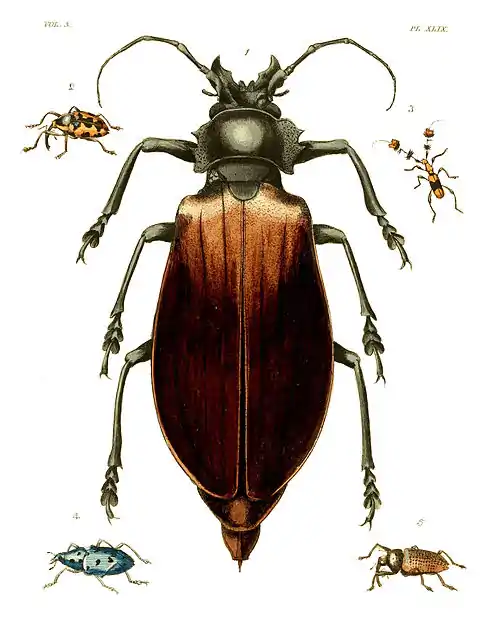
PRONUS (TITANUS) GIGANTEUS.
Plate XLIX. fig. 1.
Genus. Prionus, Geoffroy. Cerambyx P., Linn. (Subgenus: Titanus, Serv. Ann. Soc. Ent. France, 1. p. 133.)
Prionus (Titanus) Giganteus. Thorace utrinque bidentato, corpore nigro, elytris ferrugineis, antennis brevibus. (Long. Corp. 6 unc. 9 lin.)
Syn. Cerambyx Giganteus, Linn. Mant. 1. 531. Shaw Nat. Misc. t. 280. Fabr. Syst. El. 2. 261. 17. (Prionus g.) Oliv. Ent. 4. 66. p. 12. t. 6. f. 21.
Habitat: Cayenne.
HEILIPUS? SCALARIS.
Plate XLIX. fig. 2.
Genus. Heilipus? Germar.
Heilipus? Scalaris. Niger; thoracis lateribus et elytrorum disco irregulariter flavescentibus. (Long. Corp. 1 unc. 1½ lin.)
Syn. Curculio scalaris, Drury, App. vol. 3.
Habitat: Bay of Honduras.
CERAMBYX (COSMISOMA) PLUMICORNIS.
Plate XLIX. fig. 3.
Genus. Cerambyx, Linn. &c. (Subgenus: Cosmisoma, Serv.)
Cerambyx (Cosmisoma) Plumicornis. Fulvus, elytris cruce nigrâ, pedibus antennisque nigris, his scopiferis. (Long. Corp. 7½ lin.)
Syn. Leptura plumicornis, Drury, App. vol. 2. Sch. Syn. Ins. 3. 429. (Saperda p.)
Habitat: Musquito Shore, Bay of Honduras.
CYPHUS 16-PUNCTATUS.
Plate XLIX. fig. 4.
Genus. Cyphus, Schonherr. Chlorima, Dej. Curculio p., Linn.
Cyphus Sedecim-Punctatus. Cœrulescens, thorace punctis nigris quatuor, coleopteris duodecim. (Long. Corp. 1 unc.)
Syn. Curculio sedecim-punctatus, Linn. Syst. Nat. 1. 2. 618. 92. Fabr. Syst. Eleuth. 3. 509. 10. Oliv. Ent. v. 83. t. 2. f. 17. a. b. Schonh. Syn. Ins. Curcul. 1. 625. 8.
Habitat: Cayenne.
SOLENOPUS CACICUS.
Plate XLIX. fig. 5.
Genus. Solenopus, Schonherr. Odontoderes, Sahlberg. Curculio p., Drury.
Solenopus Cacicus. Ater sulphureo-squamosus, thorace bivittato, lateribus granulatis, elytris punctis magnis oblongo-quadratis et striatis. (Long. Corp. rostr. inclus. 1 unc. 3 lin.)
Syn. Curculio morbillosus, Drury, App. vol. 3.
Solenopus cacicus, Schonh. Syn. Ins. Curcul. 3. 597. 1.
Dionychus granicollis, Germ. Ins. Spec. 315. 454.
Habitat: Cayenne.
PLATE L.
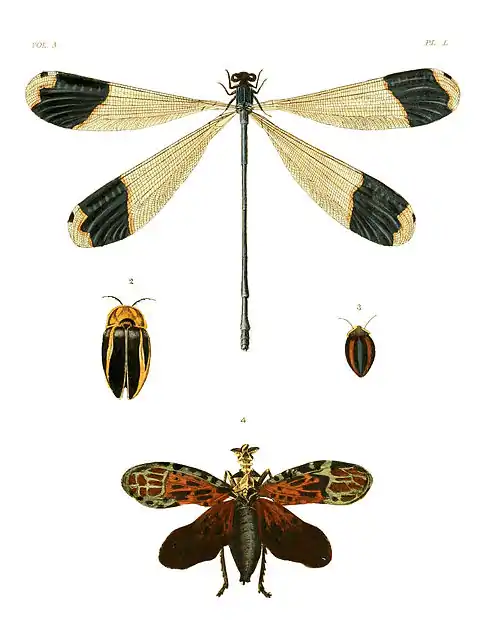
LESTES CŒRULEATA.
Plate L. fig. 1.
Genus. Lestes, Leach. Libellula p., Drury, Donovan.
Lestes Cœruleata. Cœrulea, thorace pallidè vittato, alis hyalinis fasciâ latâ subapicali cœrulescenti, stigmate nigro. (Expans. Alar. 5 unc. 6 lin. Long. Corp. fere 4 unc.)
Syn. Libellula cœruleata, Drury, App. vol. 3.
Libellula cœrulea, Donovan Nat. Repos. 4. 110.
Habitat: Bay of Honduras (Drury). "Muskito Shore, Mr. Shakespear, 1779" (Drury's MSS.).
LAMPYRIS GIGANTEA.
Plate L. fig. 2.
Genus. Lampyris, Linn. &c.
Lampyris Gigantea. Ovata depressa, thorace semi-circulari fulvo, disco irregulari, elytris fuscis vittâ laterali albidâ. (Long. Corp. 1 unc. 3 lin.)
Syn. Lampyris gigantea, Schonh. Syn. Ins. 3. 66. No. 46.
Lampyris splendida, Drury, App. vol. 3.
Lampyris Savignii? Kirby Trans. Linn. &c. v. 12. Guérin. Icon. R. An. Ins. pl. 14. fig. 7.
Habitat: Rio Janeiro.
BLATTA (PHORASPIS) PICTA.
Plate L. fig. 3.
Genus. Blatta, Linn. &c. (Subgenus: Phoraspis, Serville.)
Blatta (Phoraspis) Picta. Atra; elytris vittâ sanguineâ thoracisque margine antico flavescenti. (Long. Corp. 9 lin.)
Syn. Blatta picta, Drury, App. vol. 3. Fabr. Ent. Syst. 2. p. 10. Serville Revis. Orthop. p. 17. (Phoraspis p.)
Lampyris rufo-vittata, Schonh. Syn. Ins. 3. p. 66. No. 47.
Habitat: Rio Janeiro, Brazil.
FULGORA DIADEMA.
Plate L. fig. 4.
Genus. Fulgora, Linn.
Fulgora Diadema. Fusca, vertice, pronoti medio, elytrorum fasciâ luteis; alis purpureis, apice nigris, capitis cornu in medio dentato apice dentibus tribus majoribus. (Long. Corp. cum capitis cornu, 1 unc. 9 lin. Expans. Alar. 3 unc. 6 lin.)
Syn. Fulgora diadema, Linn. Syst. N. 1. 2. 703. 2. Fabr. Syst. Rh. 2. 3. Stoll, fig. 22. Donovan Nat. Repos. vol. 5. fol. 145.
Fulgora armata, Drury, App. vol. 3.
Habitat: Cayenne (Drury).There is a confusion in the works of the earlier authors relative to the native country of this species; Linnæus and Fabricius stating it to be India, whilst Stoll records Surinam, Drury, Cayenne, during that it and others figured by him were collected by Mons. Mallouet, who sent them to Europe, but in their passage they were taken by the Shaftesbury privateer, and afterwards sold by public auction, where he purchased them. Donovan states that two specimens he possessed were taken in Brazil; and Dr. Burmeister still more satisfactorily says, "Gleichfalls aus Sud-Amerika findet sich besonders haufig auf den Cautschuck-Baumen (Siphonia elastica)."
END OF VOL. III.